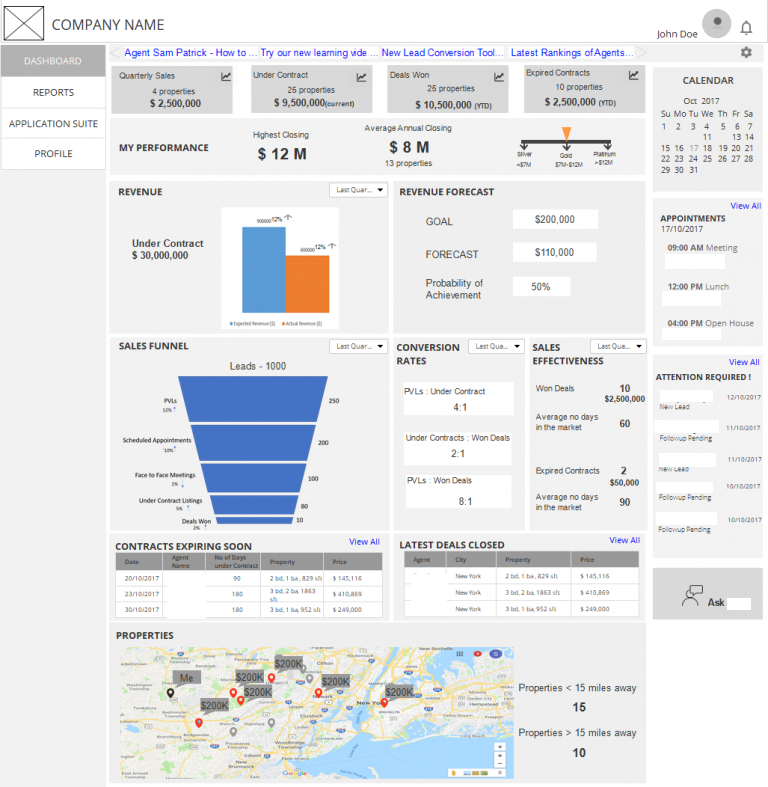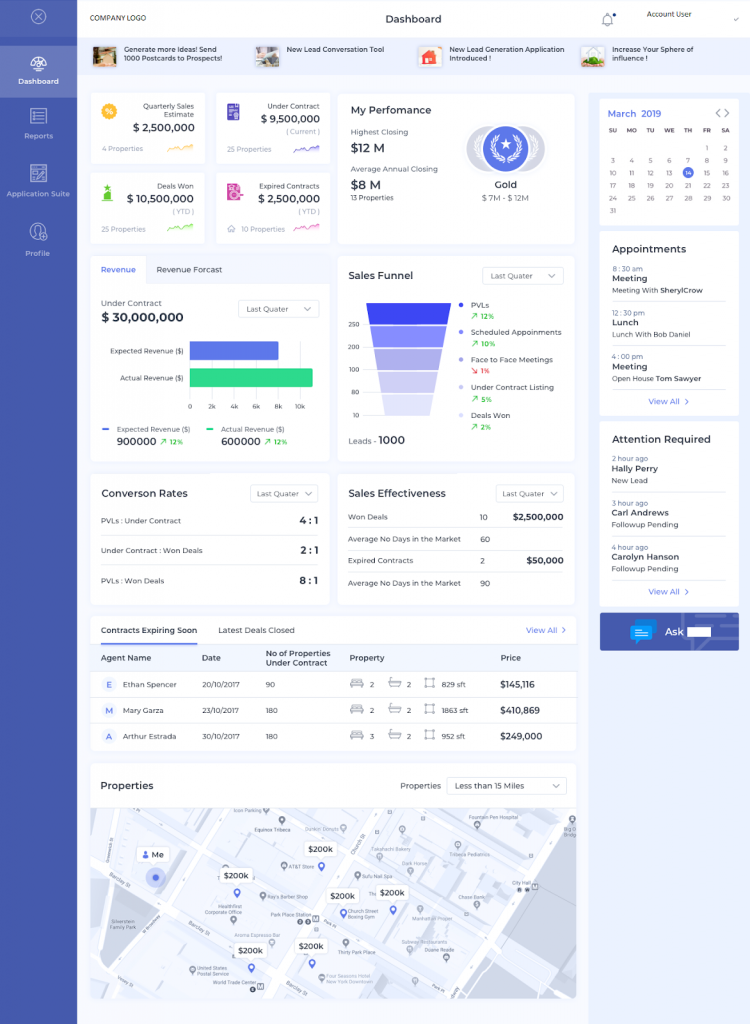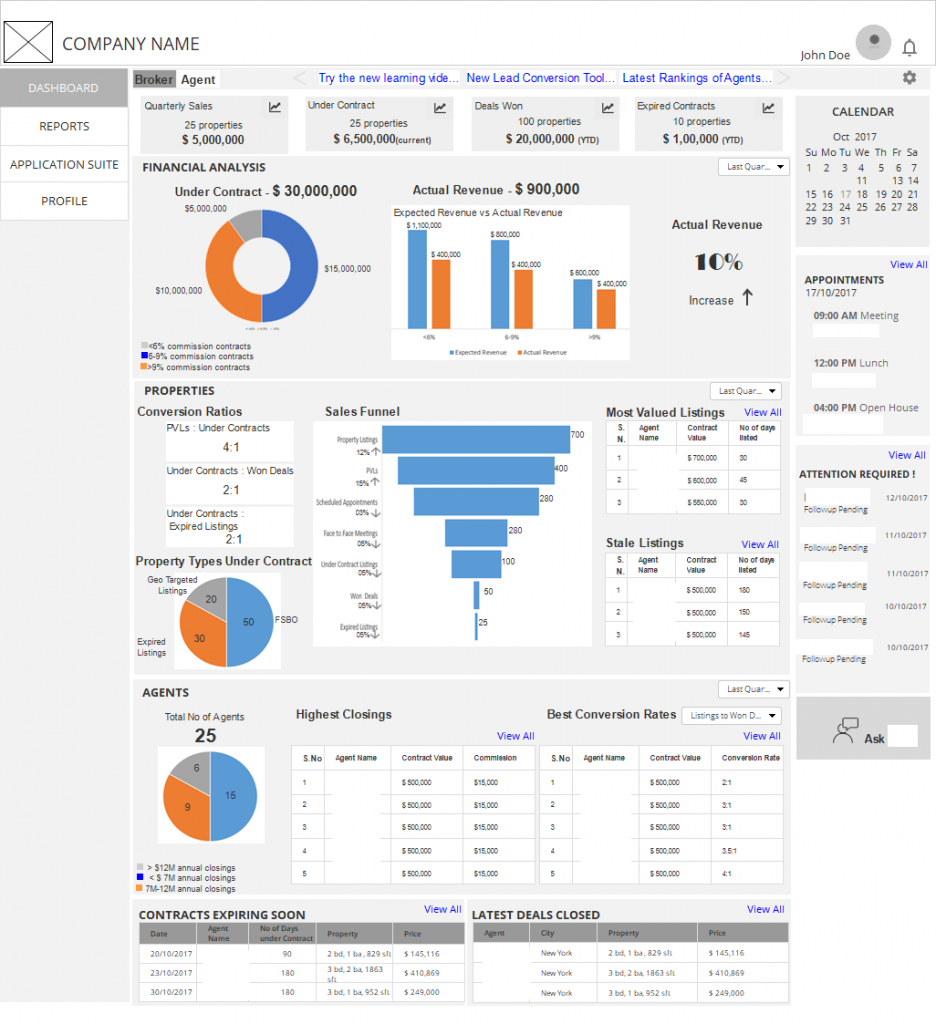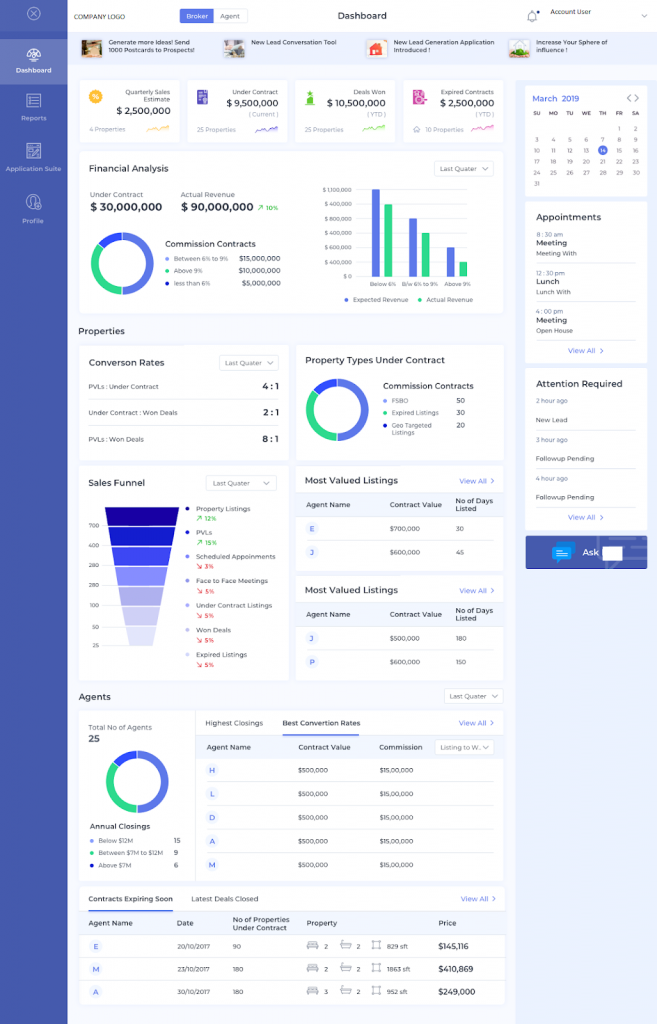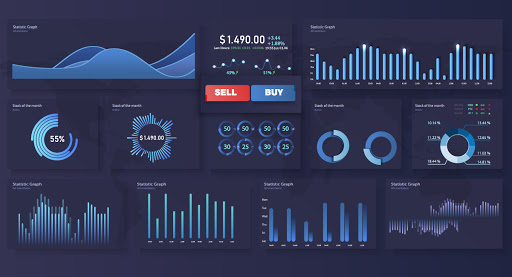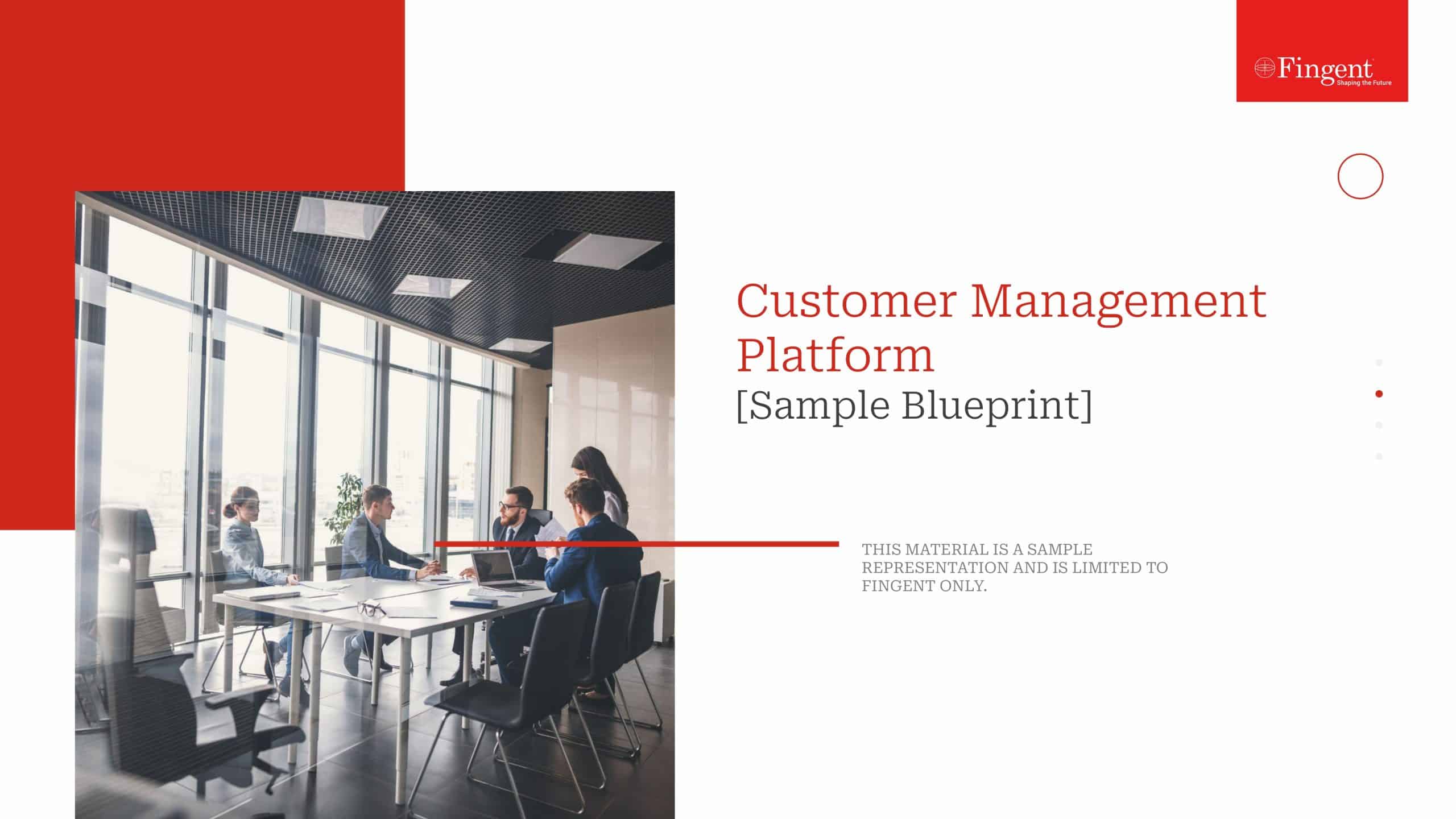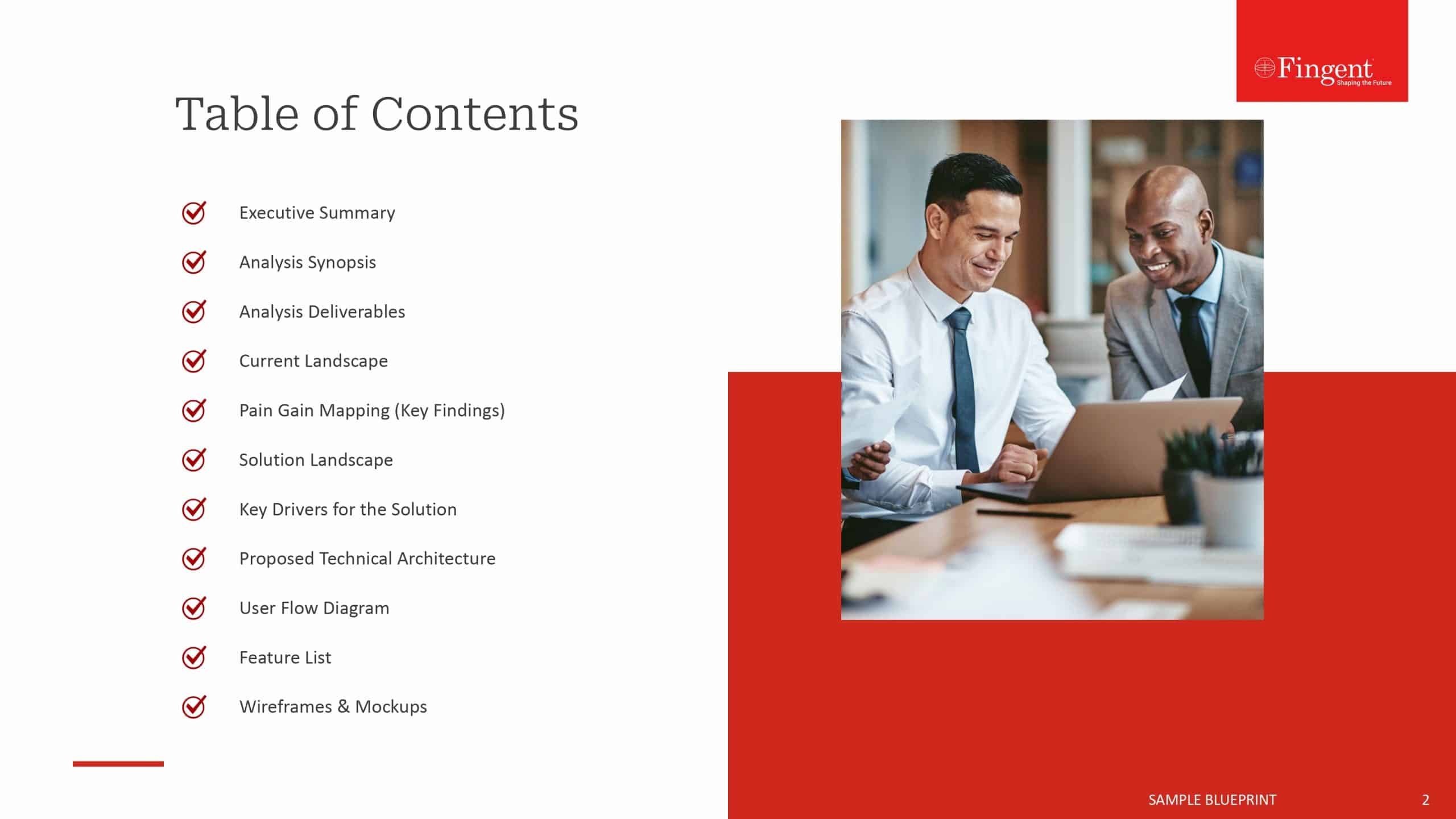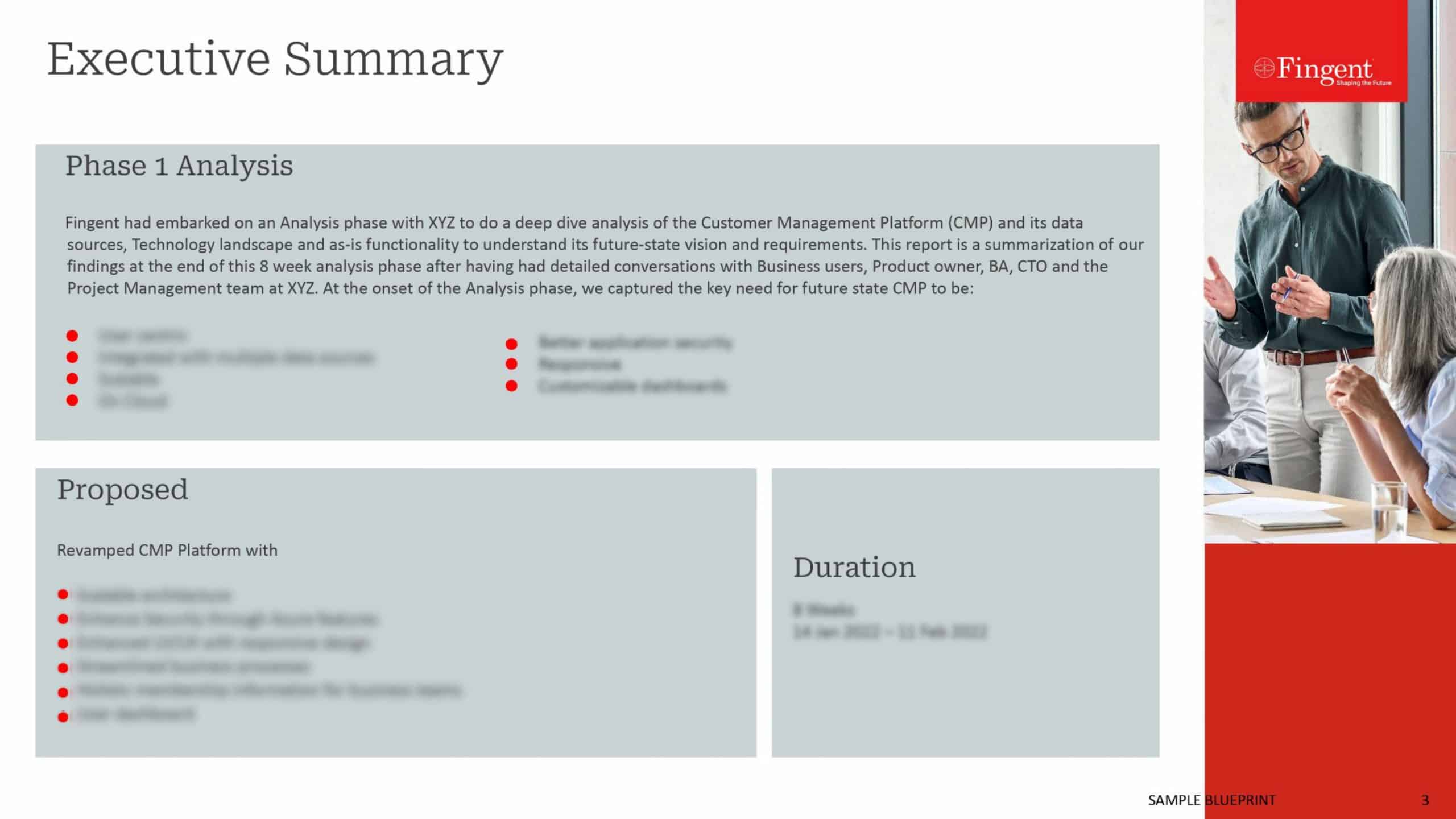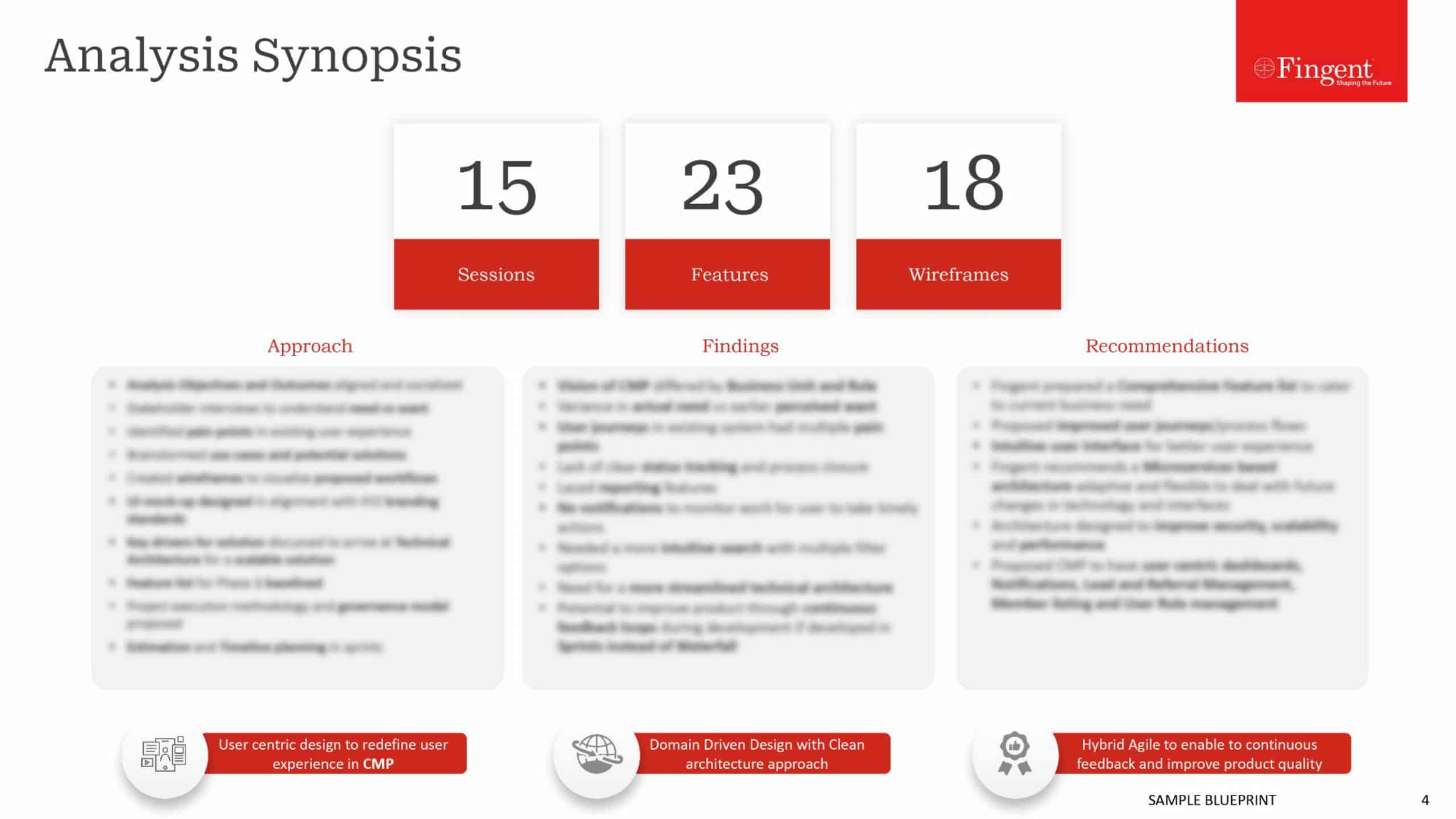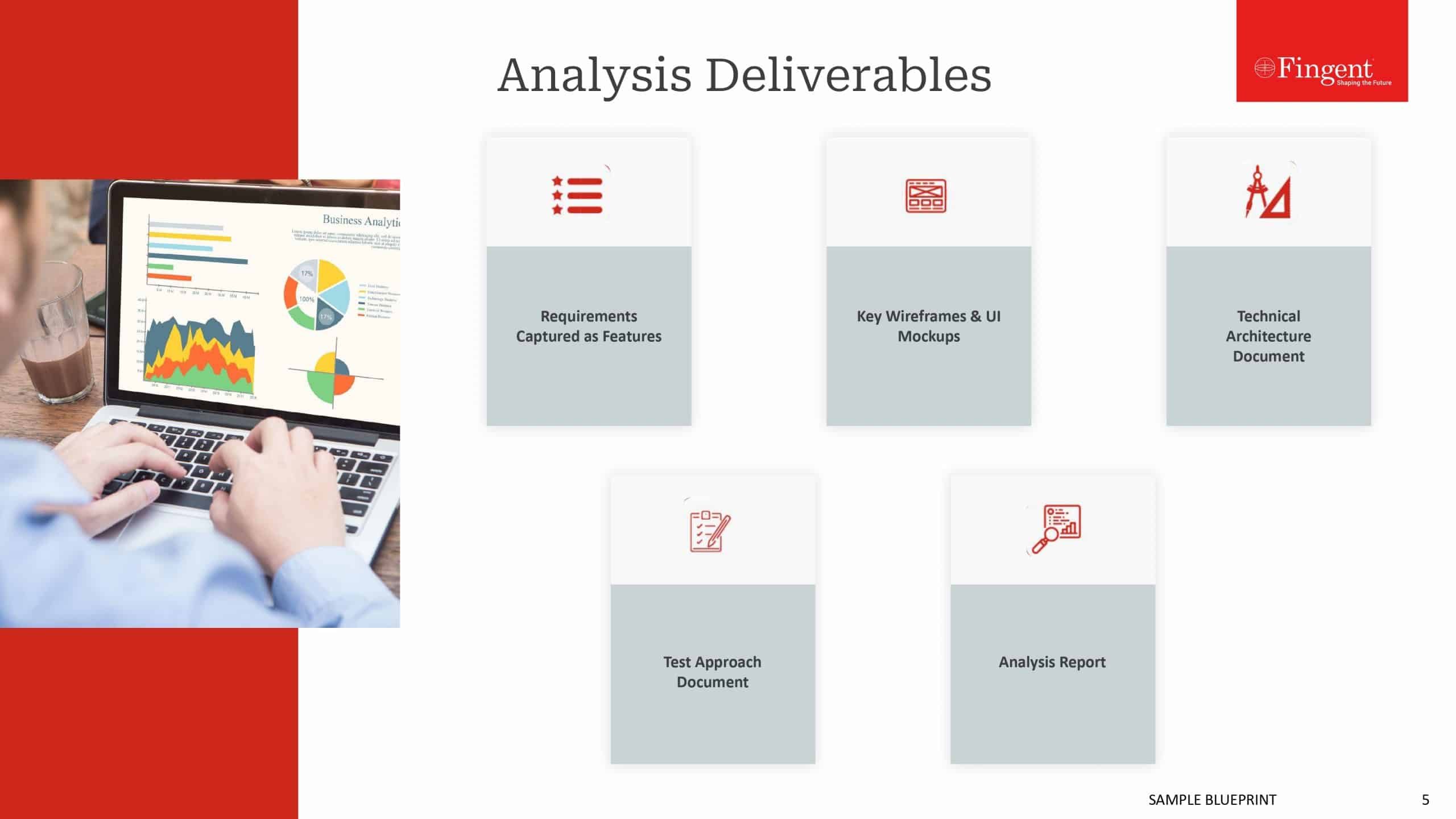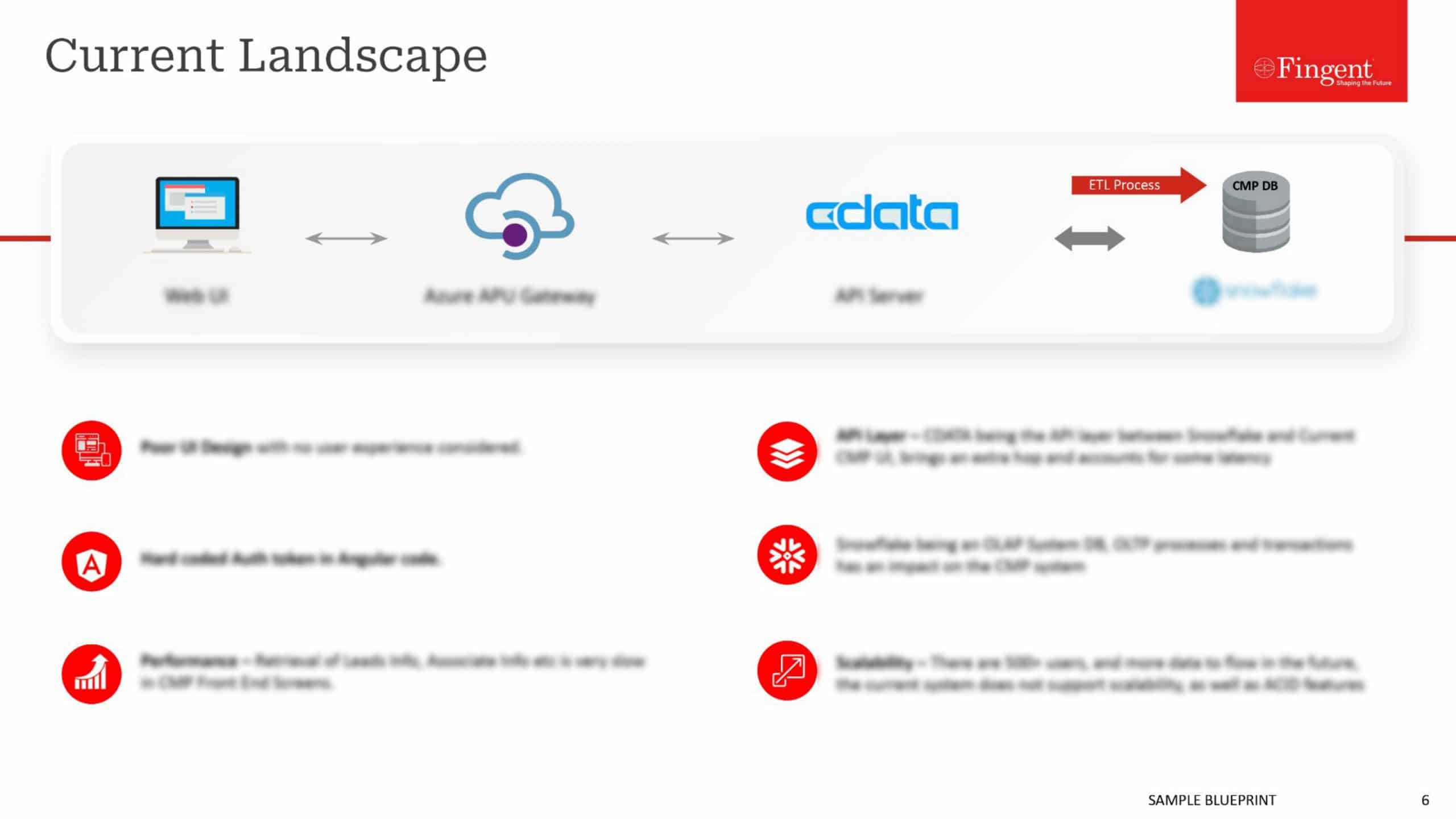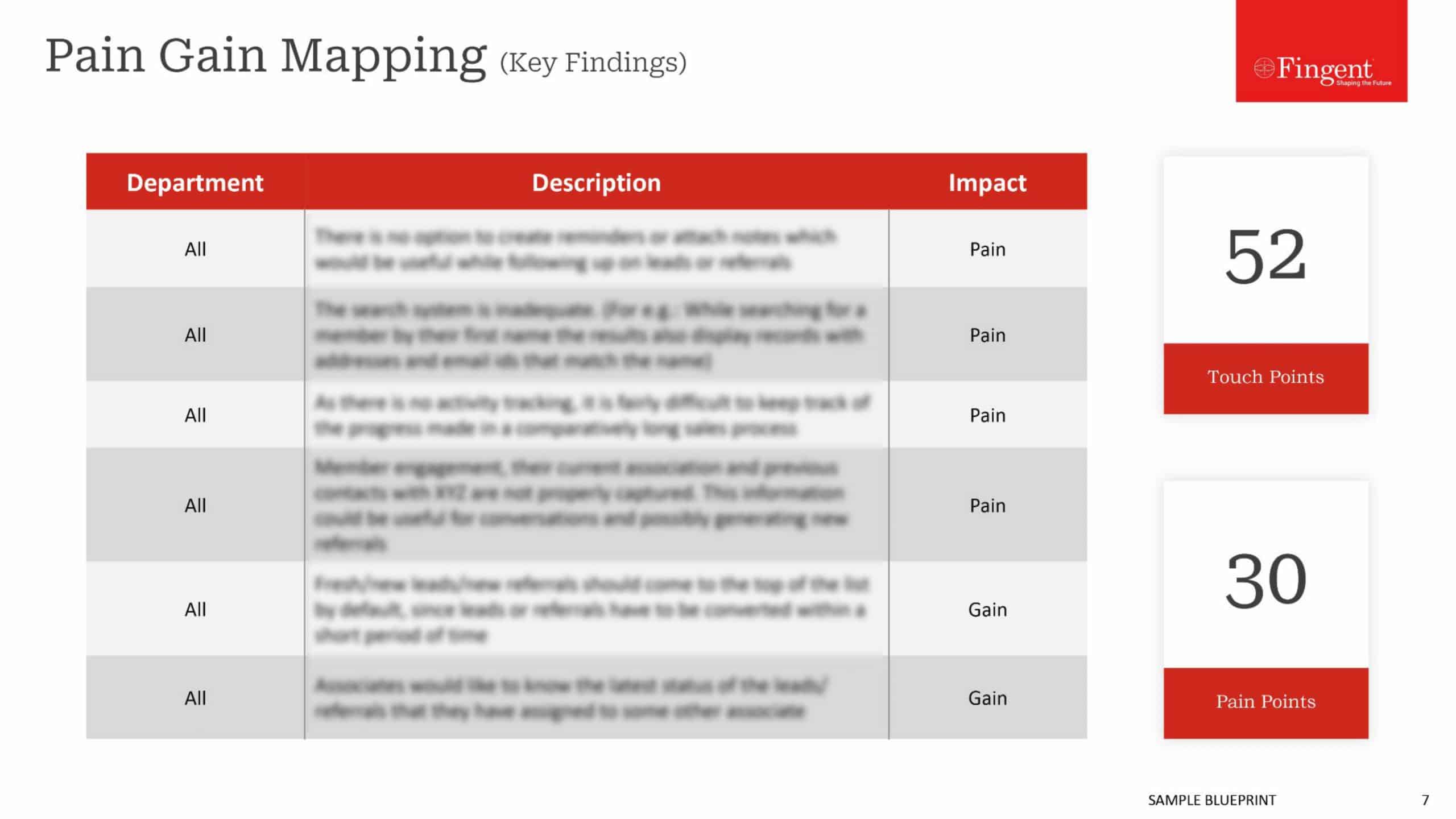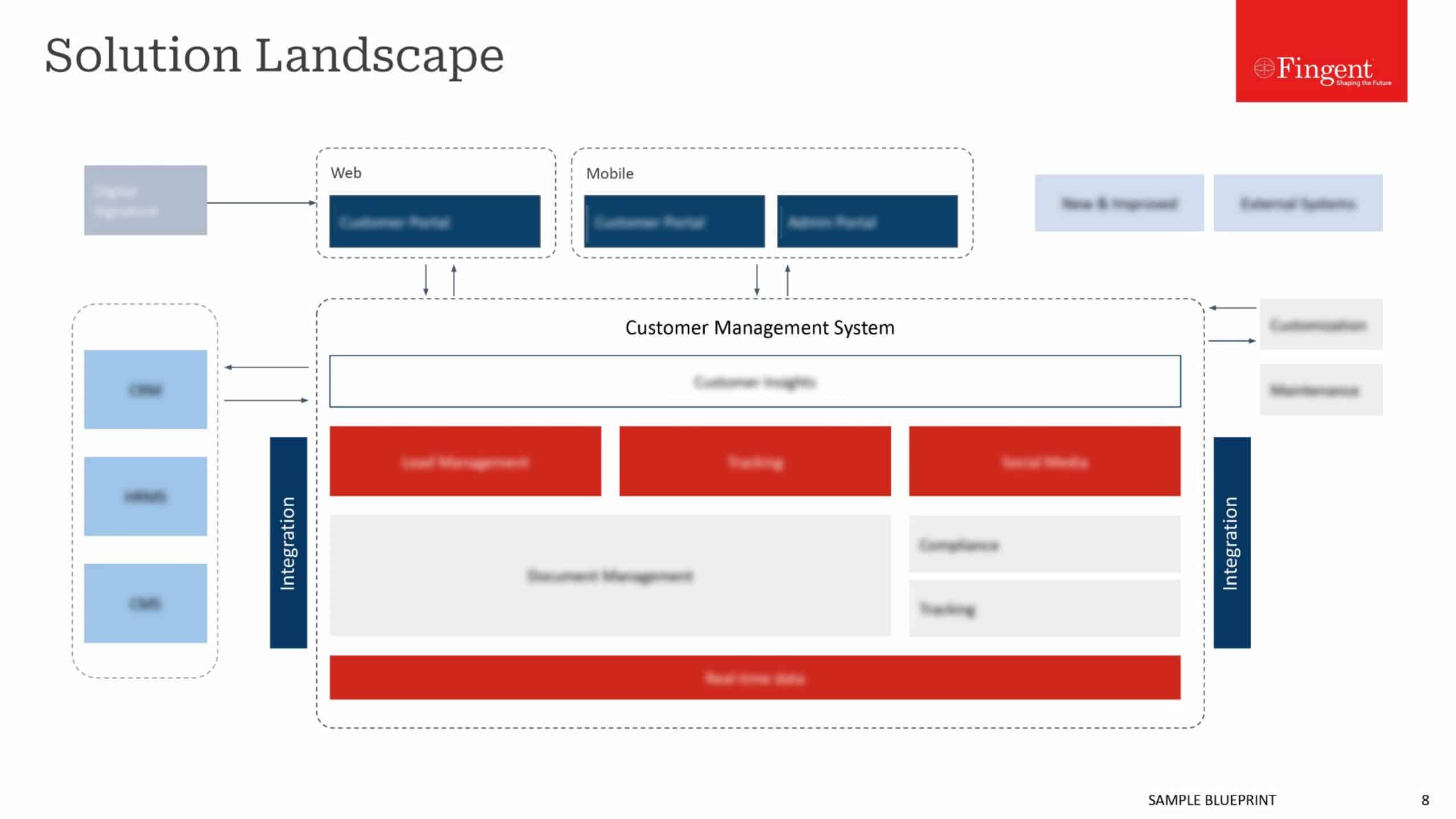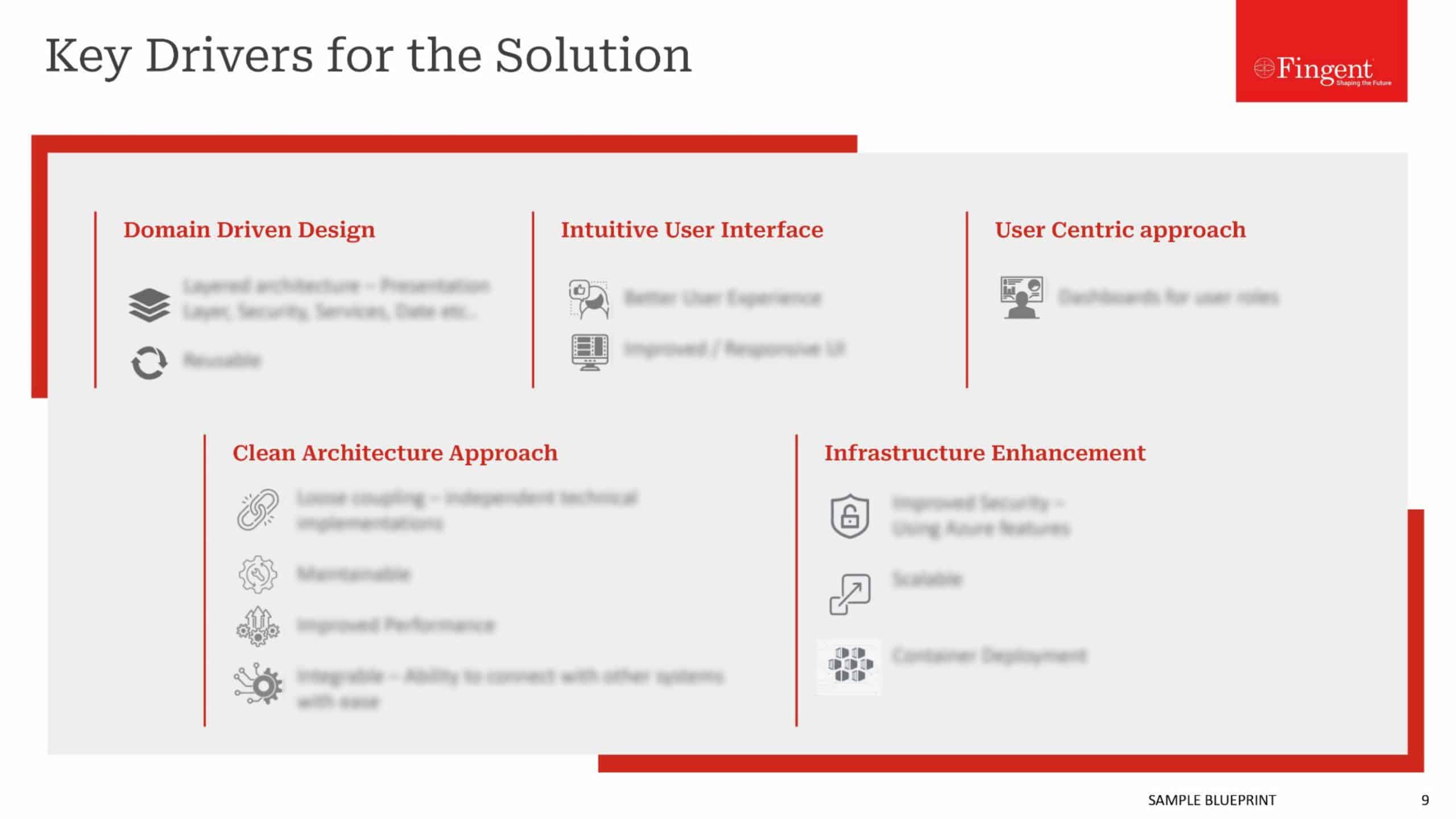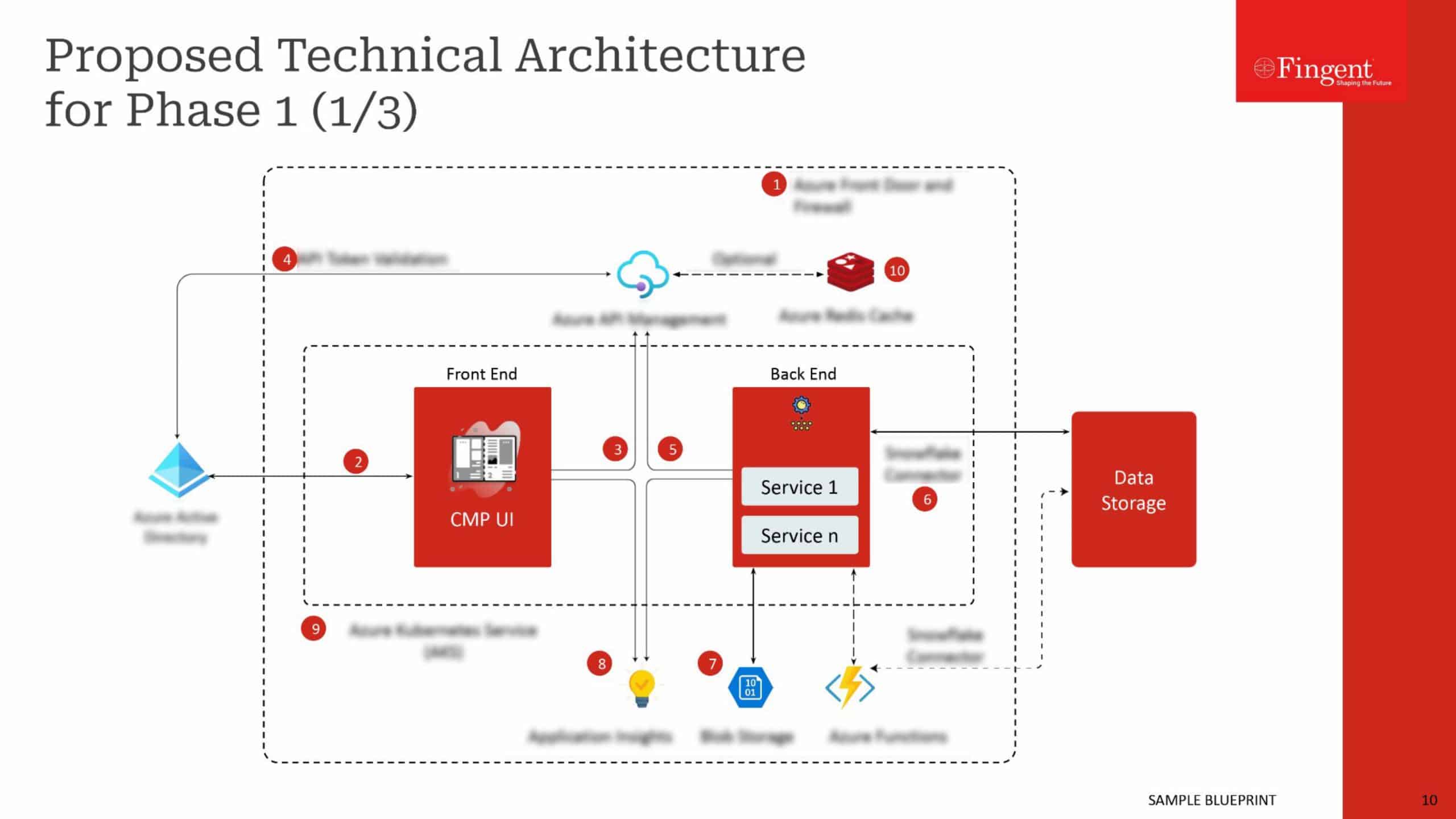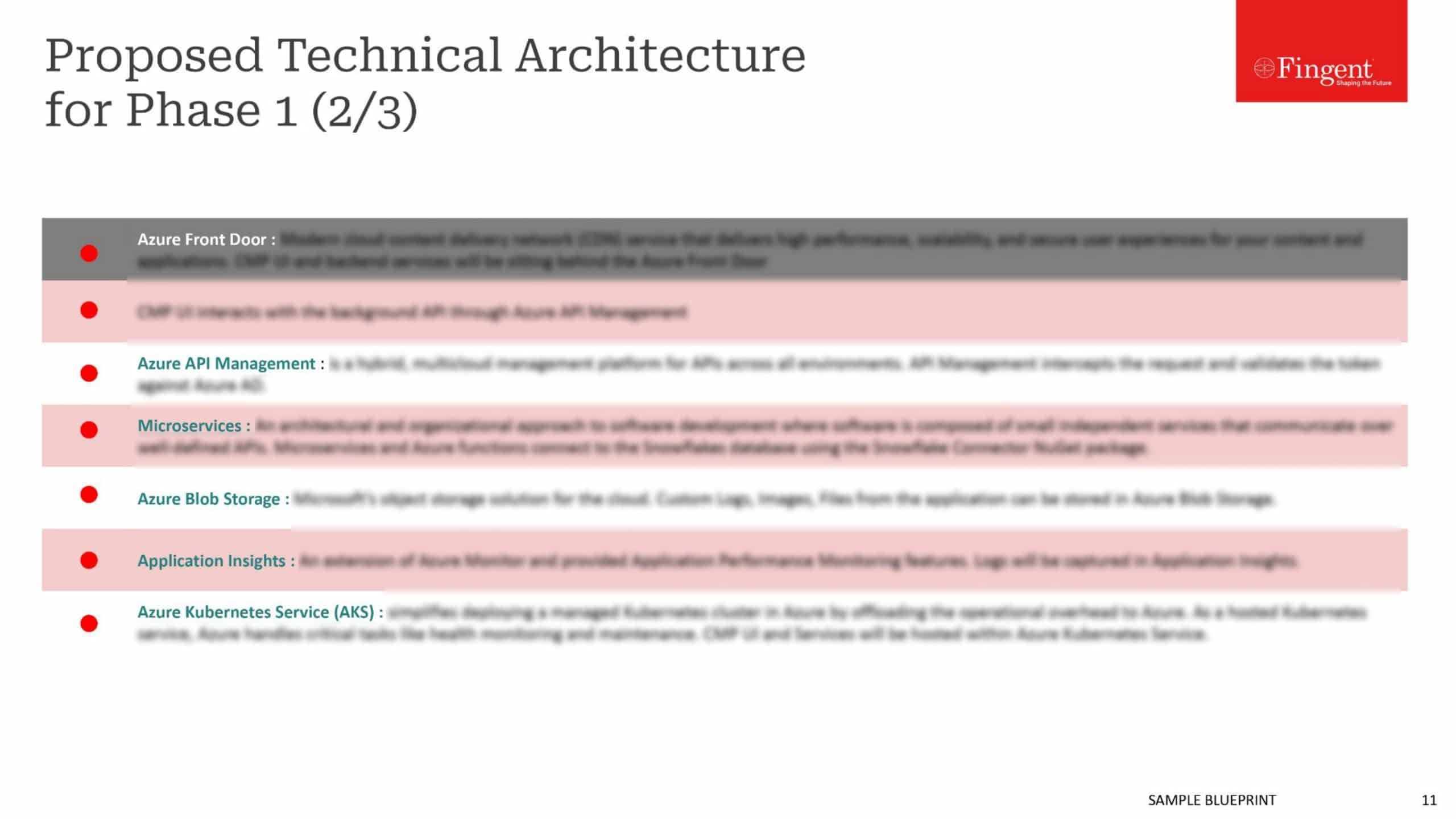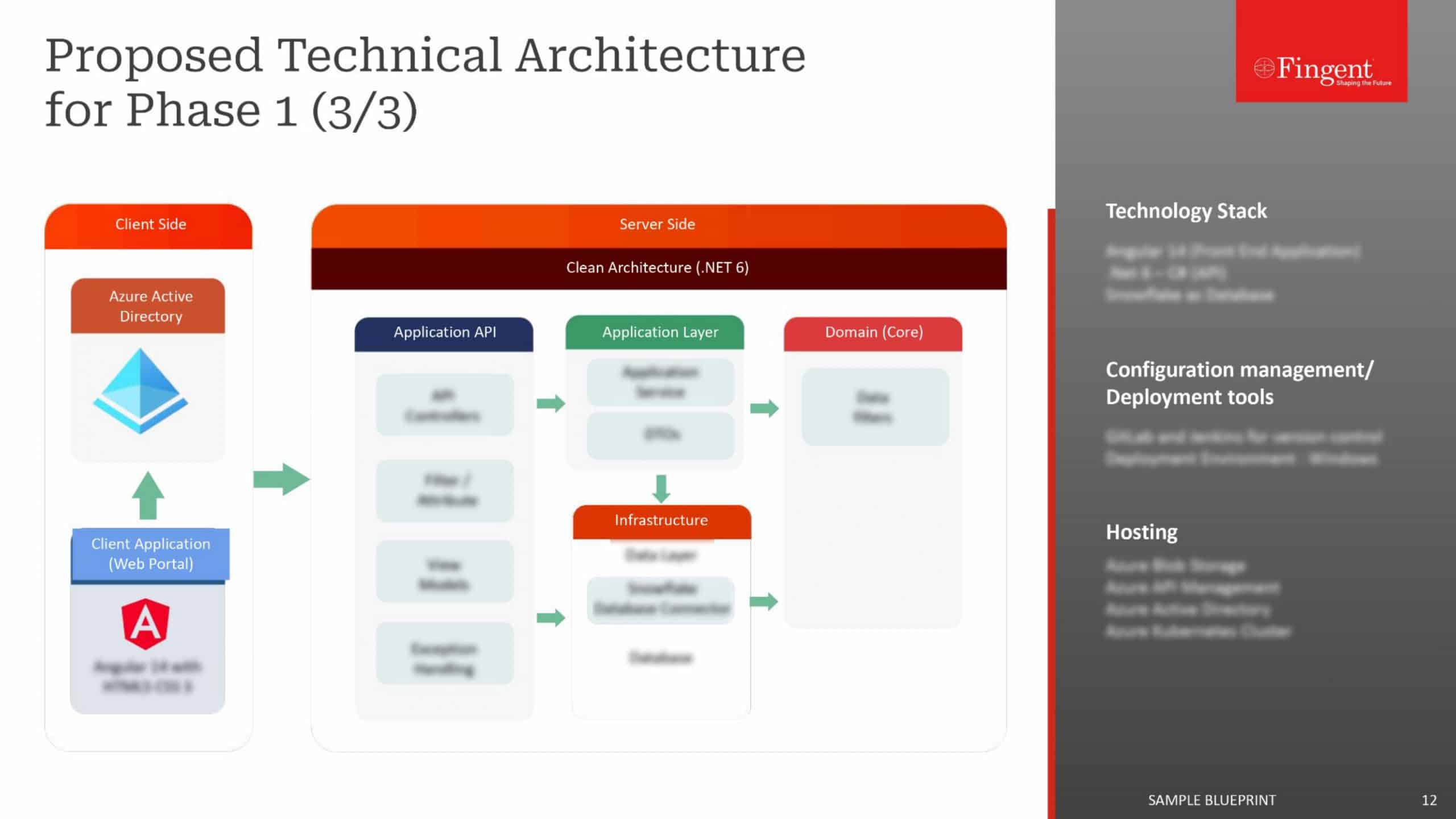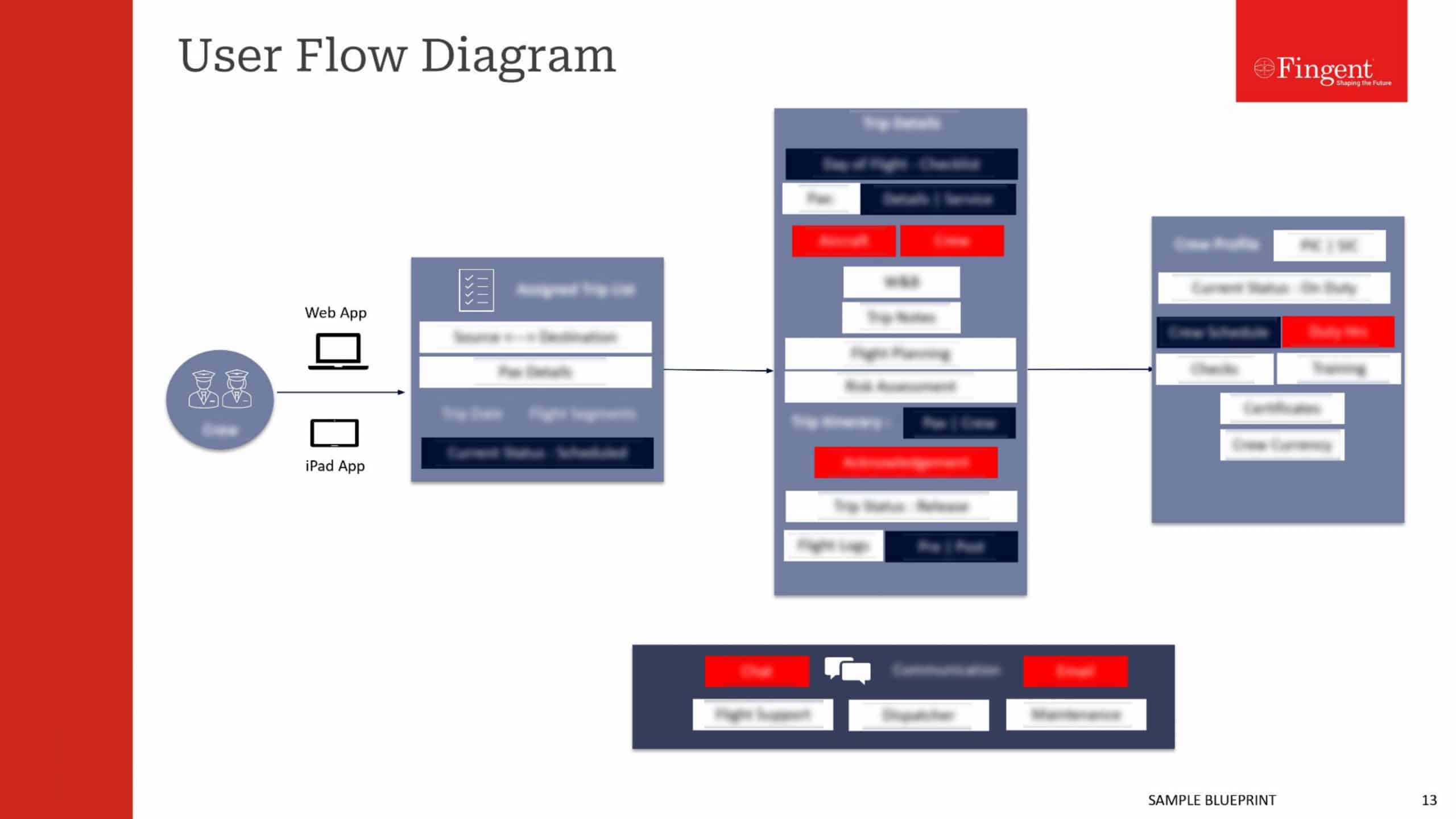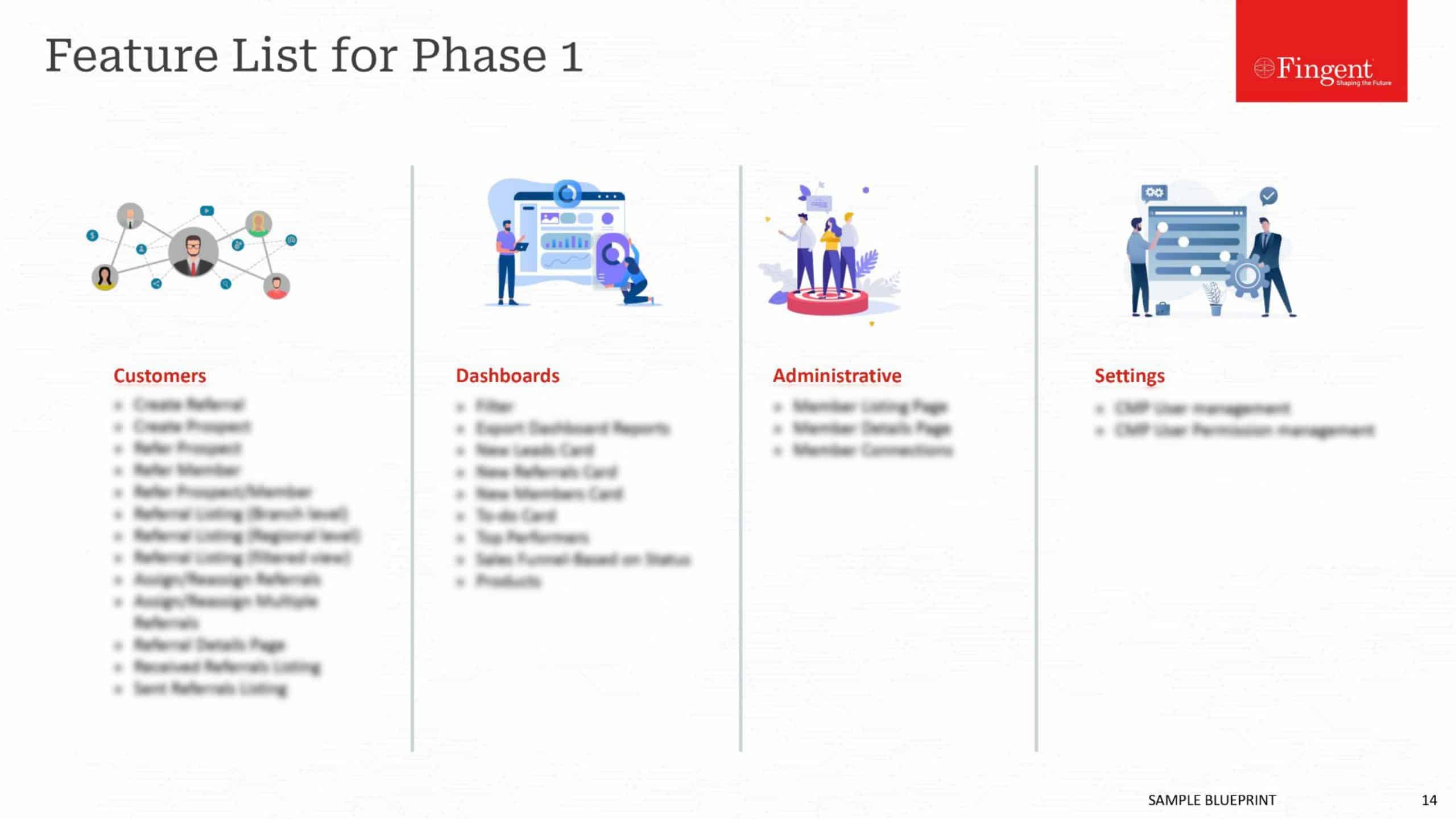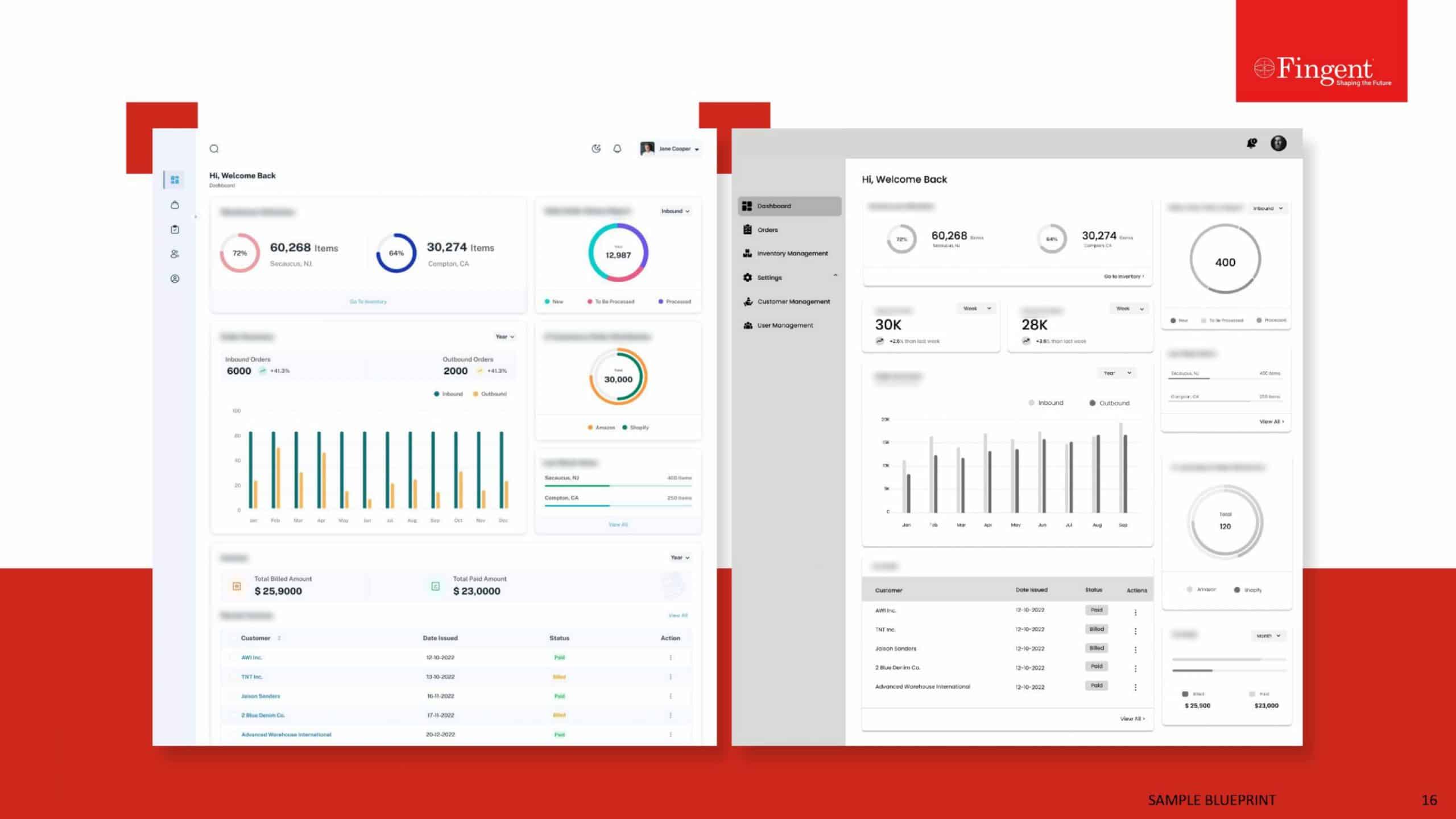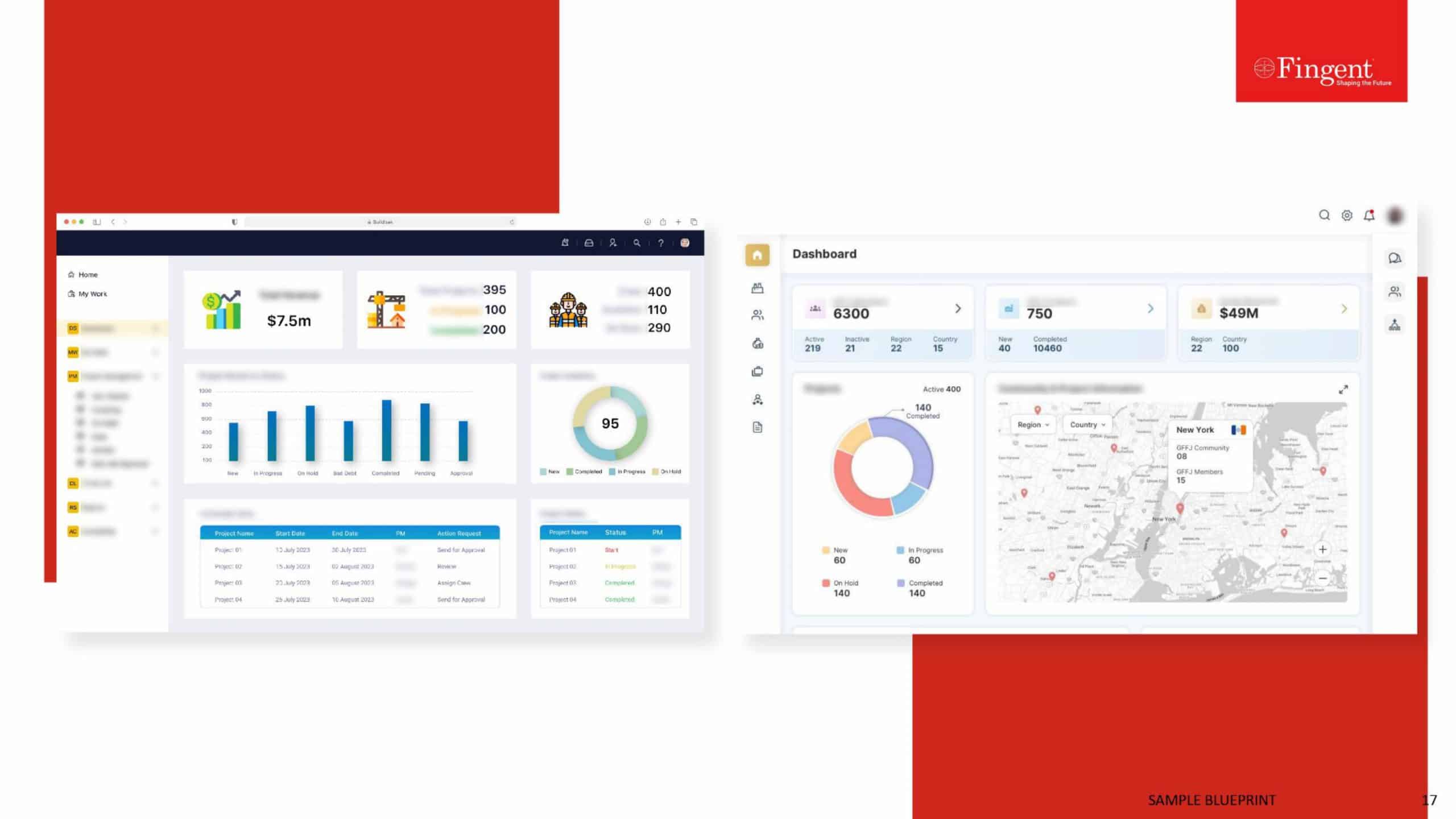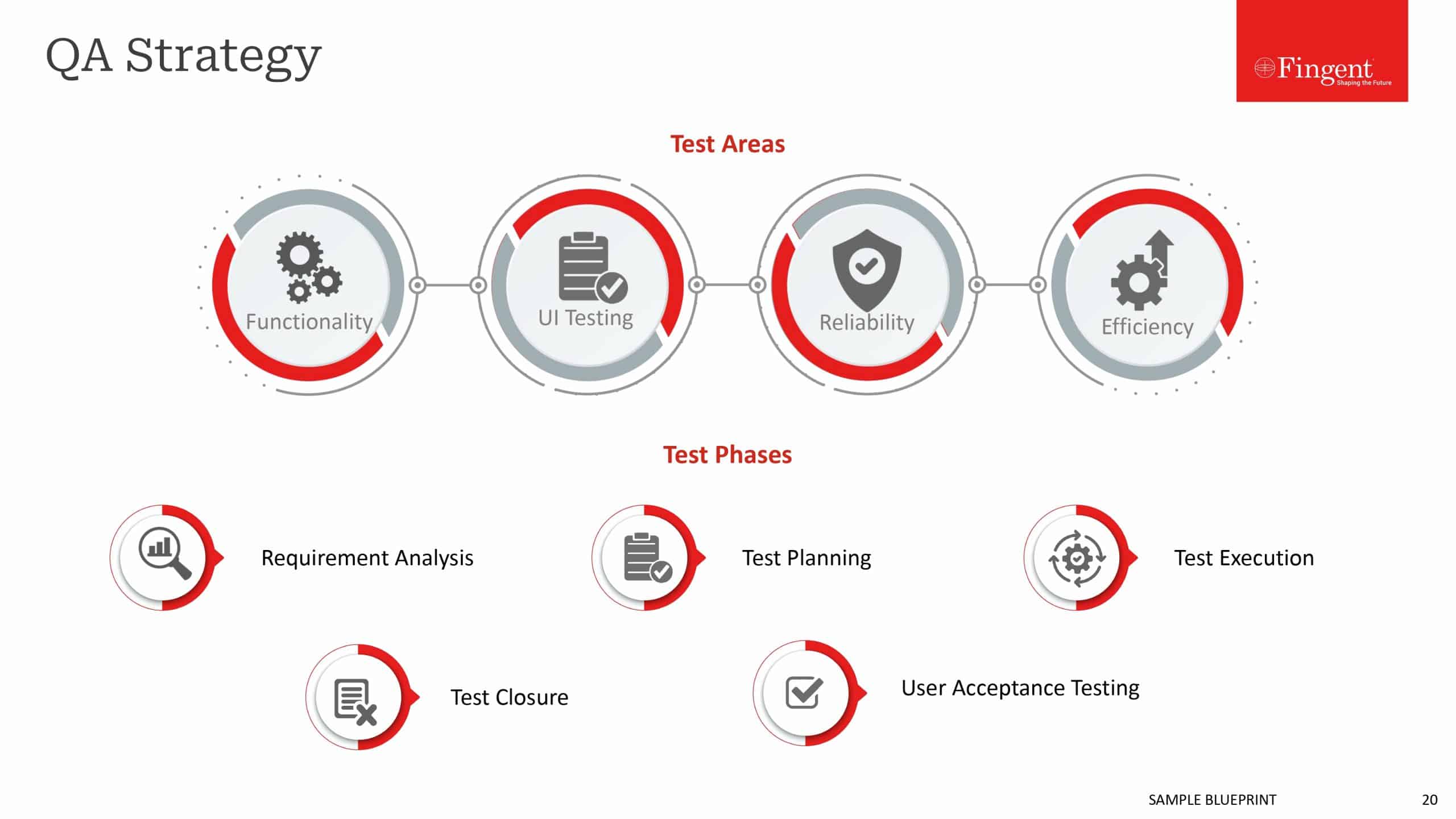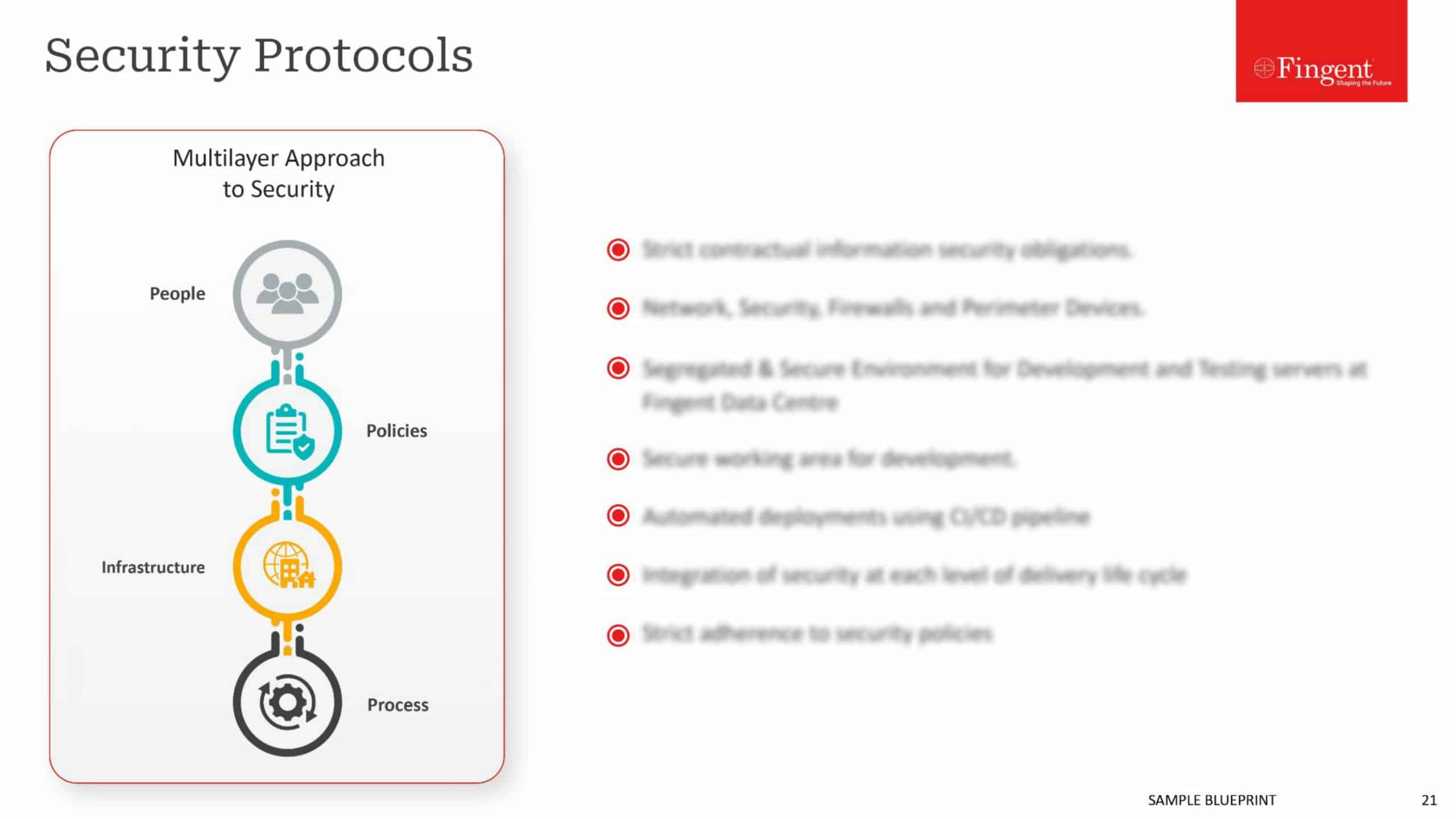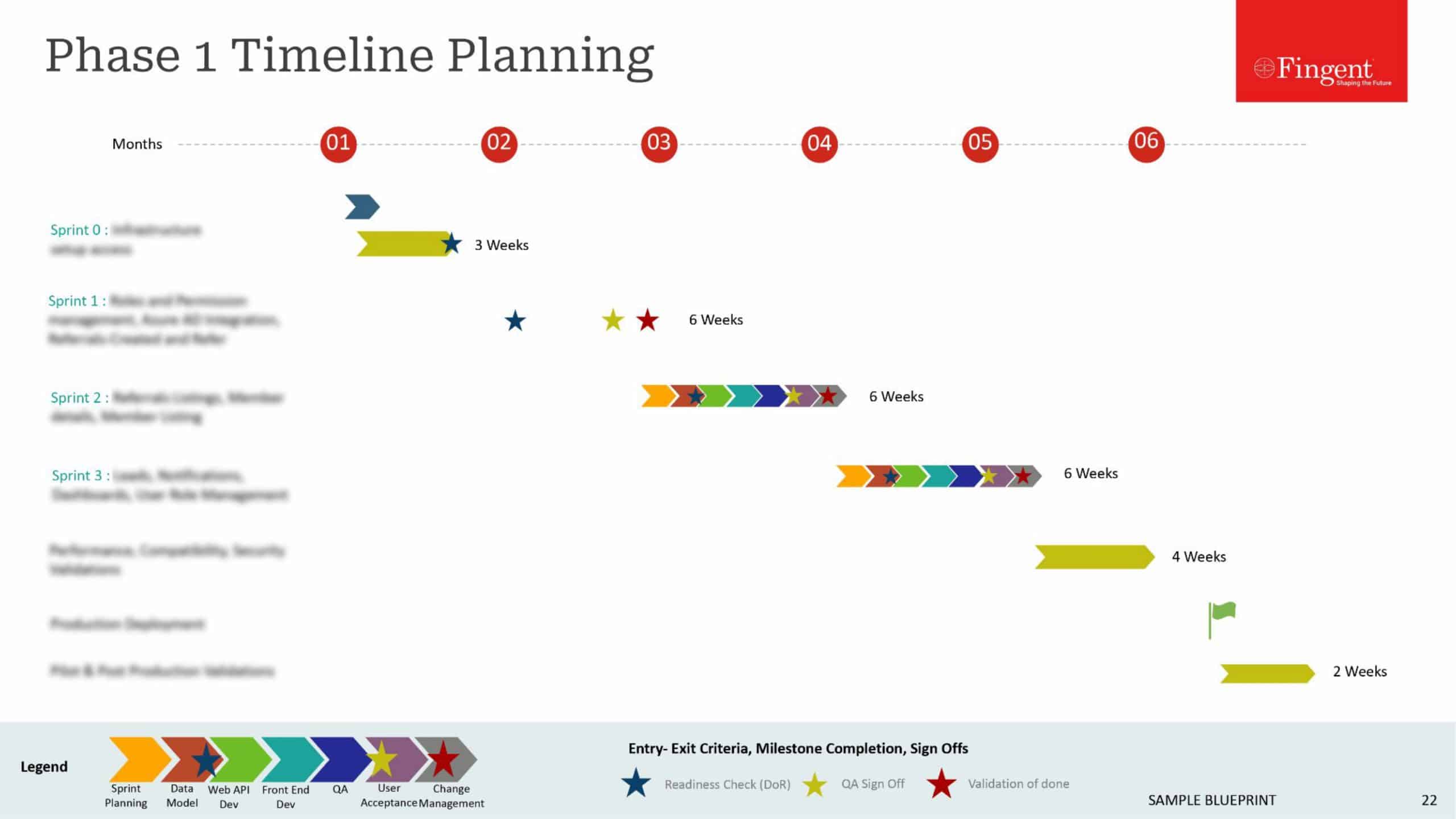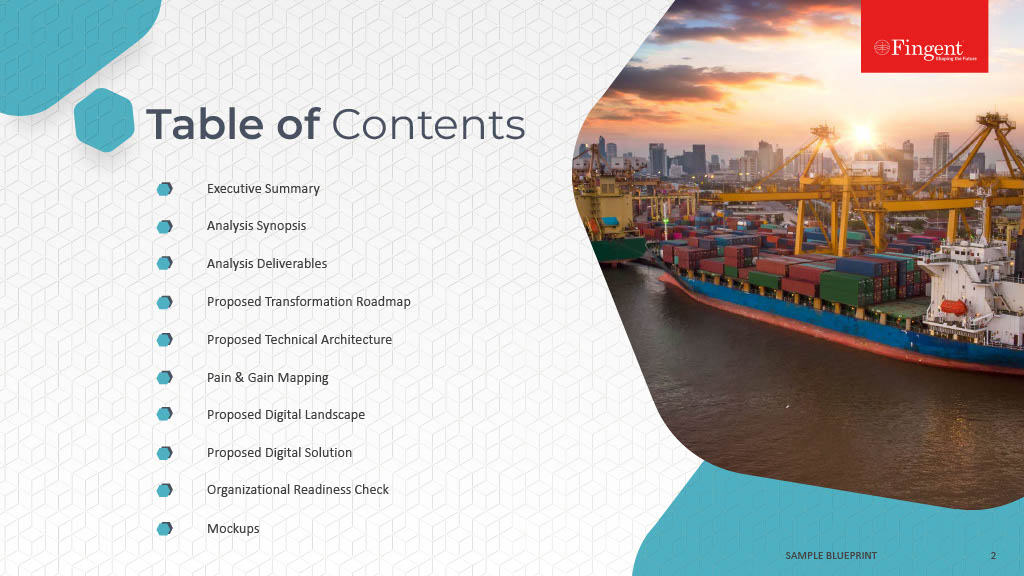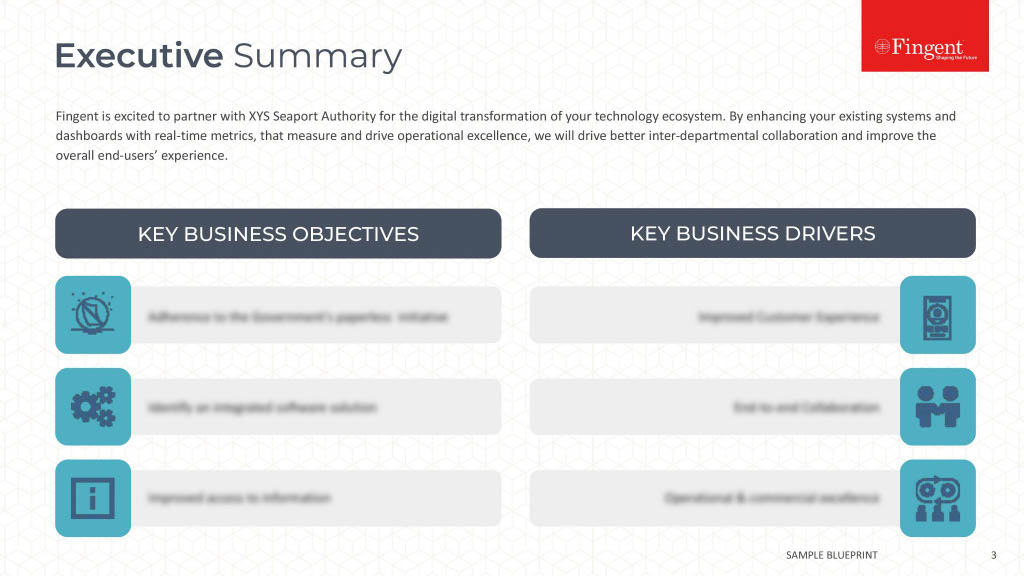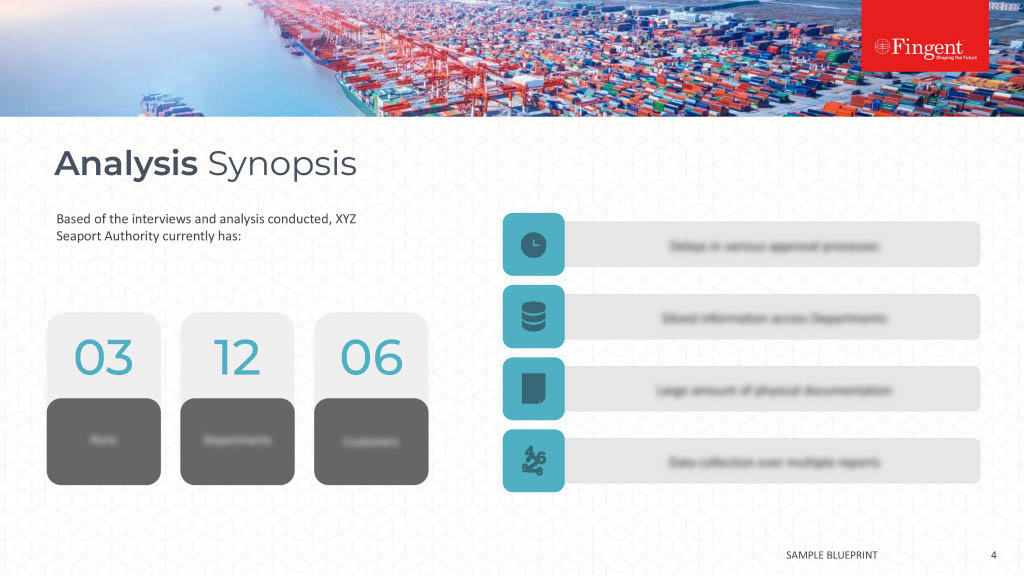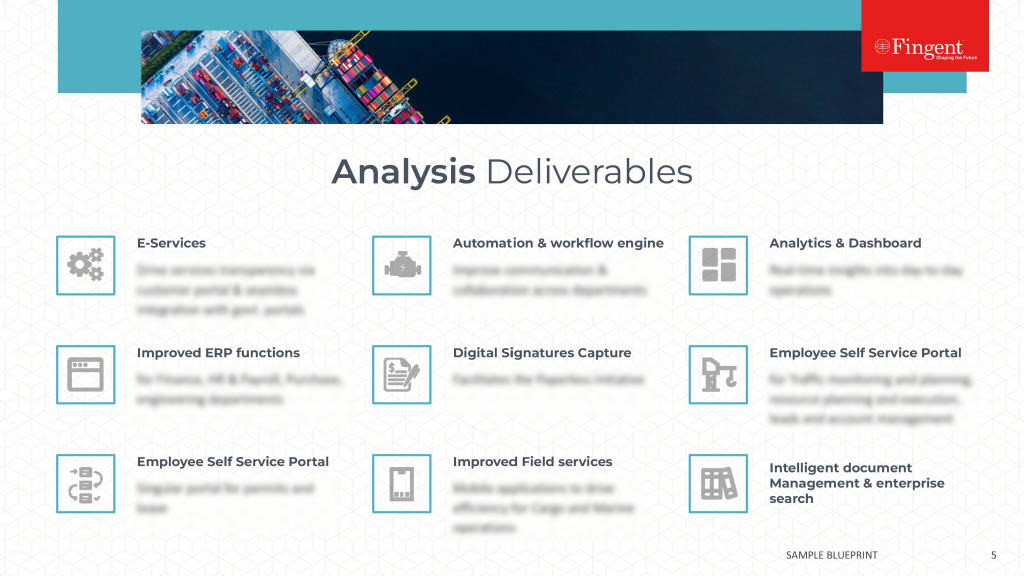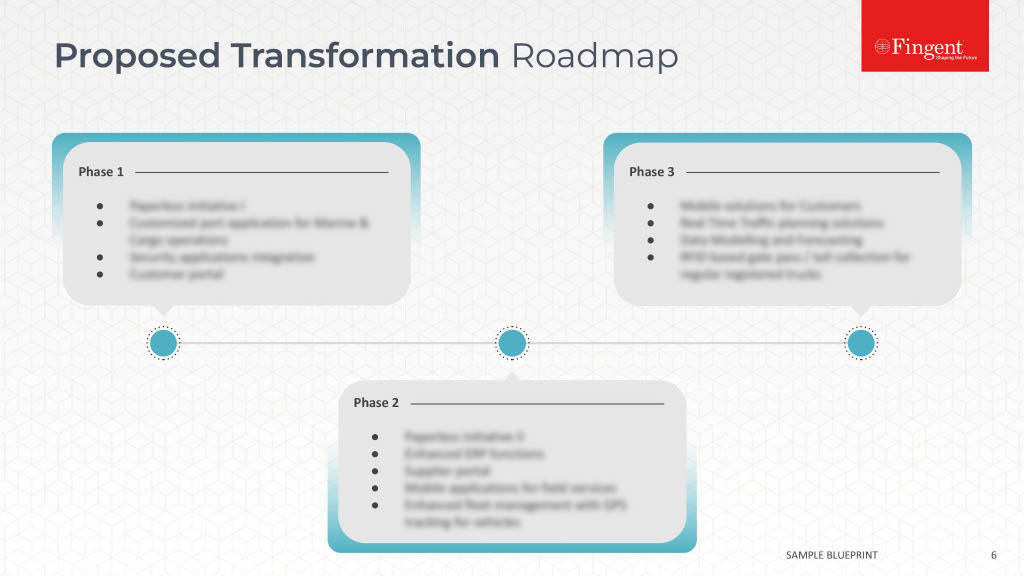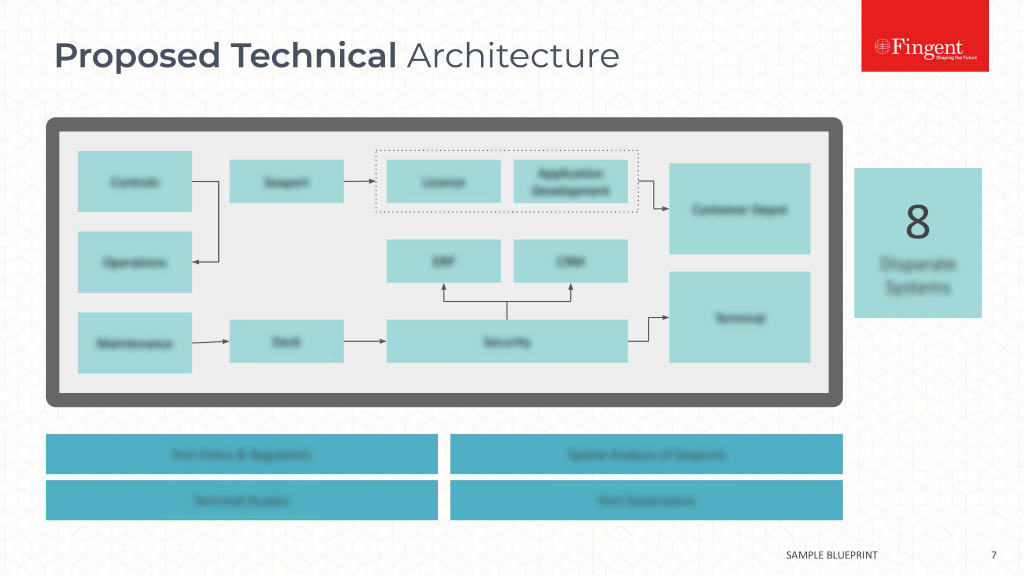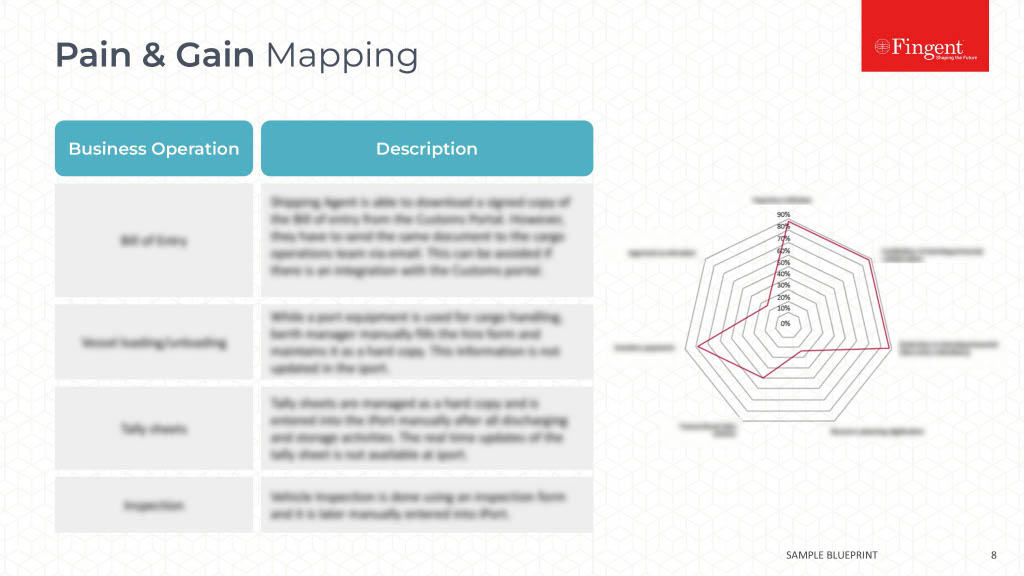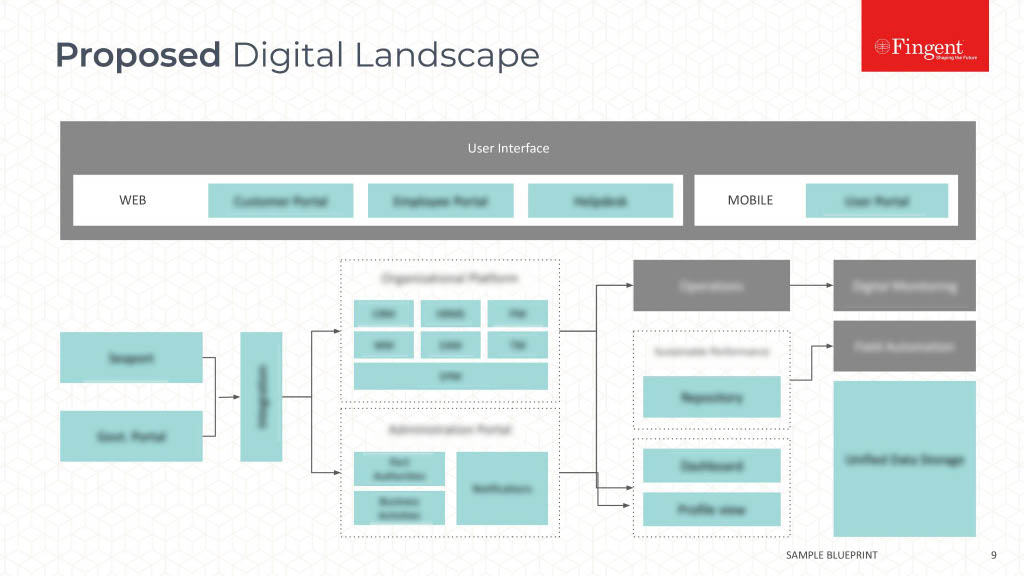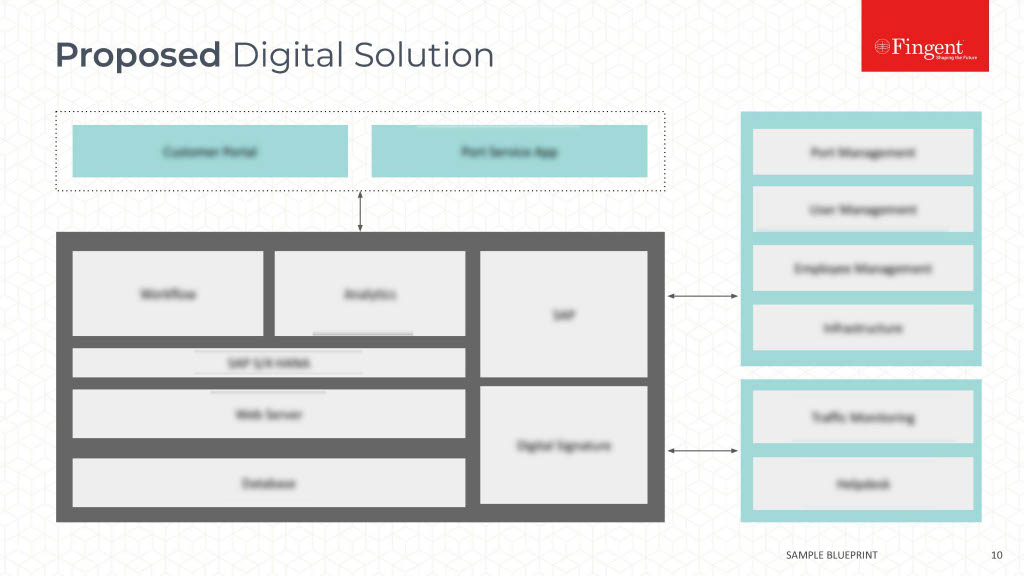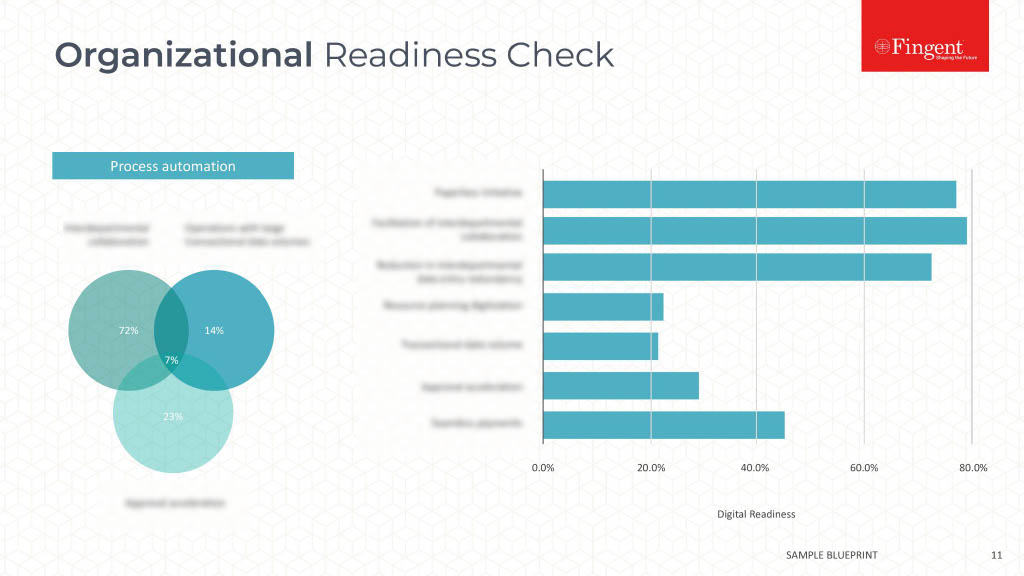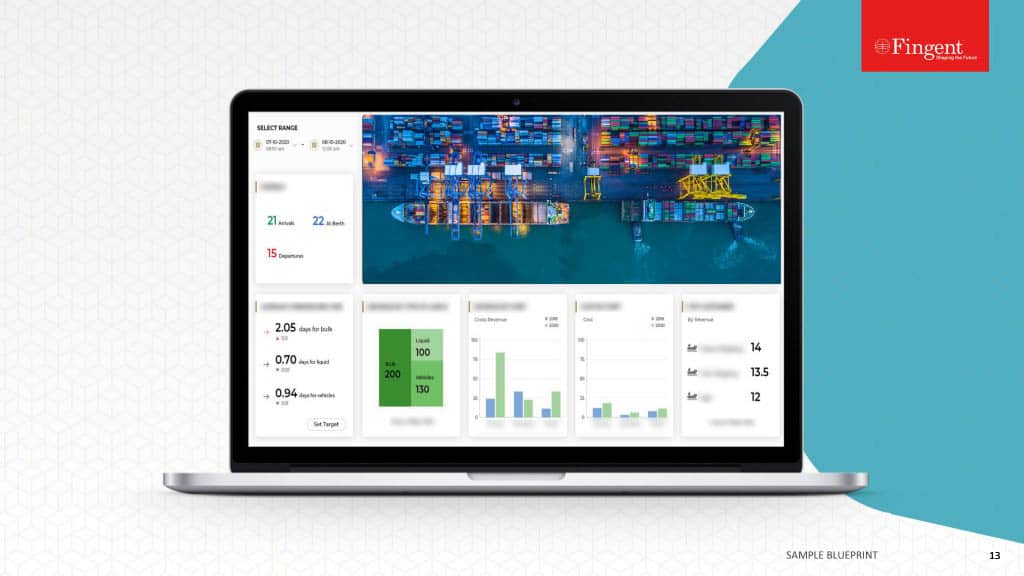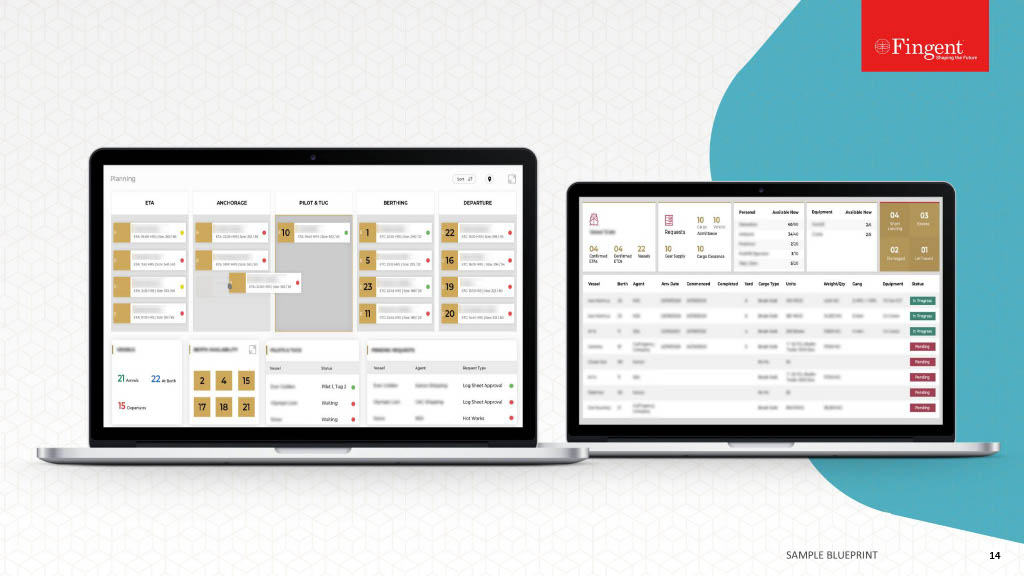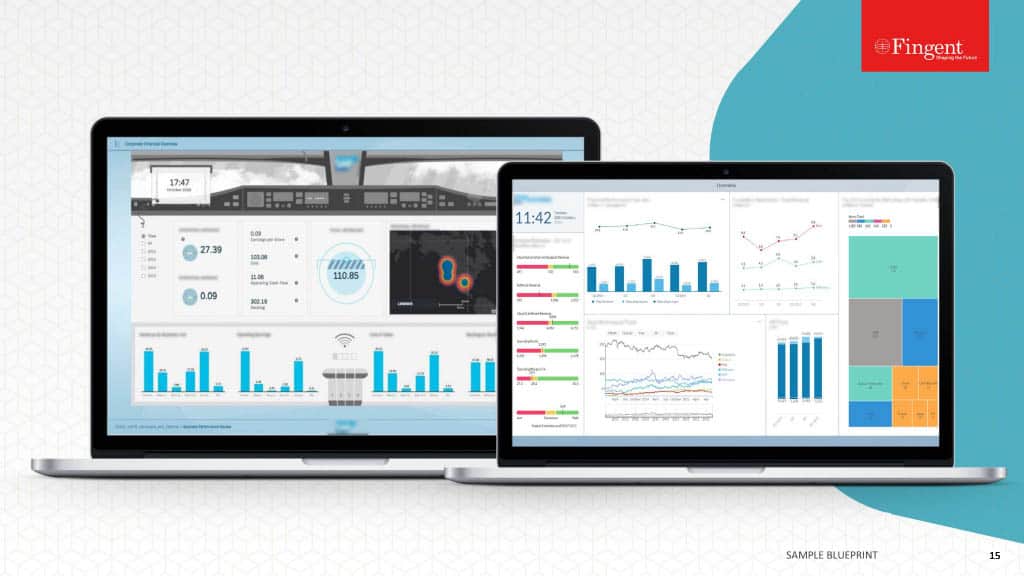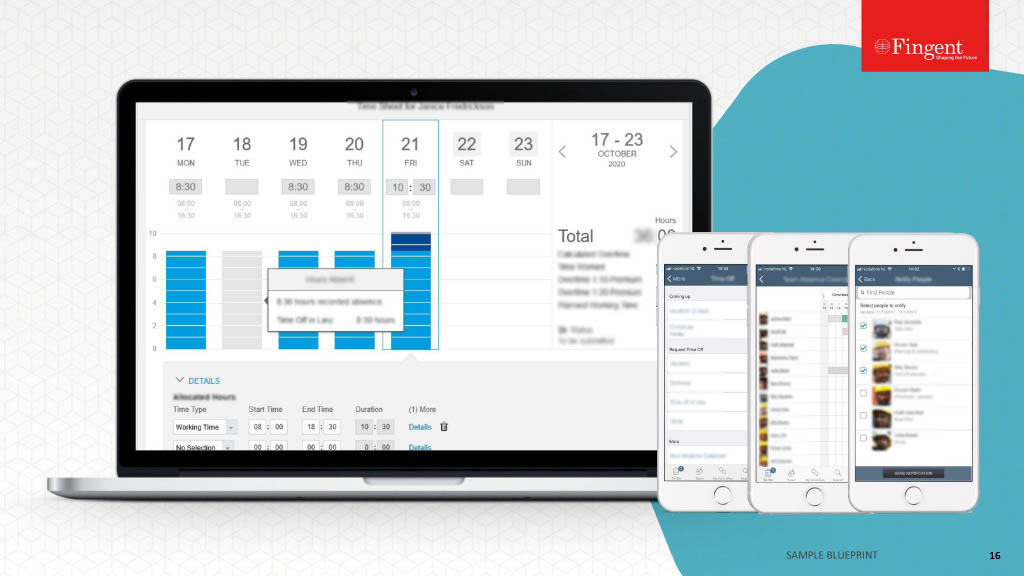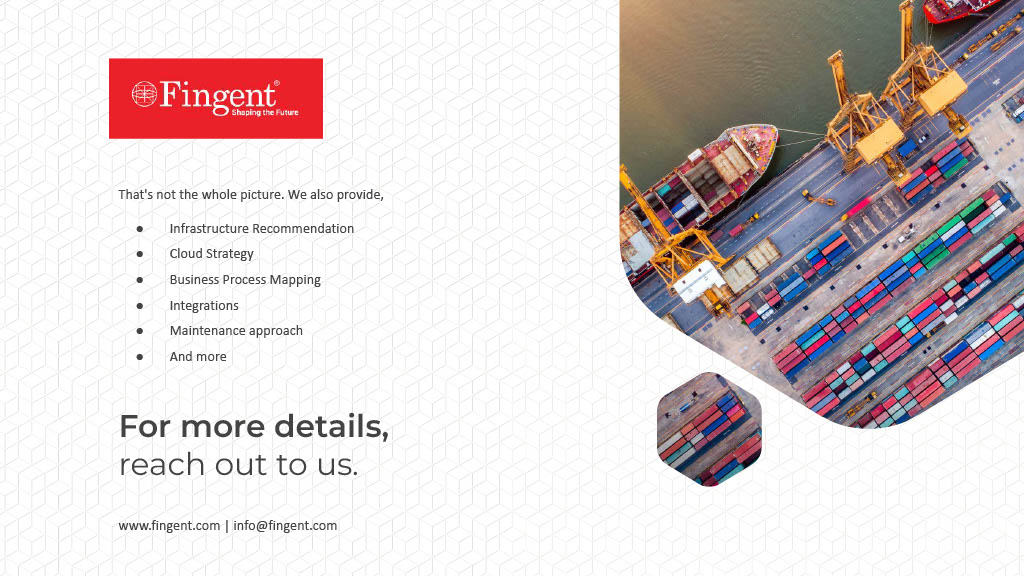Category: Technology
Imagine you are a salesman and you have logged into your system with the dashboard pulled up in front of you. Viewing the dashboard with a horde of information on it can turn out to be a very overwhelming experience. Bar charts, pies, metrics, numbers, arrows, percentages, ratios and what not go swimming in front of your eyes. Do they make any sense or do they end up confusing you? Does it include an intuitive interface allowing seamless navigation or is it cluttered and poorly organized? Well, it all depends on how well the sales dashboard is designed.
Recently, Fingent was approached by a client to develop a sales dashboard for their customers who are real estate agents and brokers. The requirement was to develop a portal for the agents and brokers to log into and a dashboard which gives a snapshot of their business performance. With this real estate platform, realtors should be able to access third-party applications to help them with the various stages of their business process.
Related Read: The Tech Disruptors in the Real Estate Space: What to Implement First?
Fig 1. Wireframe of Dashboard Designed for a Real Estate Agent
Fig 2. Sample Mockup Designed for a Real Estate Agent
In the real estate industry, data is often unstructured and unaccounted. This platform allows agents to prospect leads, manage and follow up on them, view the status, close on them and ultimately account for the costs and commissions.
Fig 3. Wireframe of Dashboard Designed for a Real Estate Broker
Fig 4. Mockup Template Created for a Real Estate Broker
Expectations from a Good Sales Dashboard
A well-designed sales dashboard is like a good storyteller. It tells you a story complete with the setting, the characters, the main plot, the conflicts, and a conclusion. This should all flow in a seamless, logical way as the eyes of the user move from the top of the dashboard to the bottom; gauging information, which is crucial to making accurate decisions.
Salespeople usually juggle with a lot of numbers. They have numbers related to revenue, sales pipeline, products and services, customer base, forecasts, financial data etc. These numbers help them analyze and make critical decisions on the next move to steer their business forward to success. If these numbers are all scattered around, a salesperson may end up spending precious time gathering data and in the process slip on making important decisions.
Now, imagine if all these numbers come across as a story. Accordingly, the salesperson is able to quickly view the Key Performance Indicators (KPIs) of their business, make a conclusion and plan for the next moves. That is what a good sales dashboard aims to achieve.
A good sales dashboard gives an unbiased true picture of the day to day workings of one’s business. It provides an illustrated view of KPIs and other information crucial in the sales process.
Related Read: Ok Seriously, How Important Is Data Visualization?
Besides, a well-designed sales dashboard should also offer access to real-time data. With this real-time data, salespeople can continually monitor the sales pipeline and activities for making crucial decisions.
The design is yet another leading factor in ensuring better user experience. The logical arrangement of the metrics and other information contribute to effortless navigation all the while ensuring that the most important information is accessed first.
Designing a Sales Dashboard
Now, on the other hand, designing a sales dashboard is an equally daunting task. How do we represent all those numbers in a visually pleasing and logical manner? Furthermore, which numbers to choose from the many, that would ultimately matter the most to the client.
Keeping in mind the following tips will help you design an effective sales dashboard.
1. Getting Your Story Right
A good understanding of the client’s business and its KPIs will help you build the story. Identifying the pulse of the business by tapping on which will give you a correct understanding of the business’s lifeline is the key. Following are some metrics that are generally used in sales –
-
Revenue
This is the key indicator denoting how well the business is doing. Revenue is compared over time (monthly, quarterly, yearly) or with the projected versus actual revenue. It can also be compared to the costs and expressed as a return on investment (ROI). Another way of representing it is to show profits after all the costs are deducted from the revenue. Finding out from your clients which figure would best be useful to them will help you in the design.
-
Forecast
The client can integrate a system to predict their future sales and revenue based on their past backlog, current pipeline, employee performances, market conditions etc. Showing this data on the dashboard will help them see the direction their business is taking.
-
Sales in Numbers and Value
From where is all the revenue coming? Is it from just one product or are all the departments making enough sales? These questions can be answered by displaying the sales in numbers and value. This will give more clarity on the inner workings of the client’s business.
-
Sales Pipeline
The sales pipeline reflects the number of deals in each stage of the sales process. The stages can be open leads, qualified leads, face to face meetings, proposal stage, and closed deals. The number of deals in each stage will help the salesman asses whether they have enough incoming leads to sustain their business, and also whether they have an appropriate distribution of deals to meet their sales targets. It also helps in forecasting revenue in the near future.
-
Lost Deals or Backlog
Negative metrics such as the number of lost deals or the backlog from the previous financial cycle, on the dashboard help in critical decision making. It can tell the salesman where their business is lacking and what it is that they need to focus on.
-
Conversion Ratios
Conversion ratios tell the efficiency of the various stages in the sales process. Numbers such as these – the ratio of open leads to qualified leads, the ratio of qualified leads to closed deals, the ratio of open leads to closed deals etc. help in understanding where the work is getting piled and identifying the bottlenecks faced in the business.
-
Attention Required/Overdue items
Salespeople would appreciate if they can get hold of a list of items on the dashboard, which needs their immediate attention. Overdue tasks is another area which needs to be highlighted in the day to day functioning of the business.
-
Performance
A metric that reflects the sales effectiveness or achievements of a salesperson in line with the company strategy and targets would summarize their performance and also act as a motivating factor to push them towards achieving more.
2. Making Data Comparisons for Deriving Insights
One can gather meaningful insights from data when a comparison is made. Therefore, the way these metrics get compared side by side to derive a logical conclusion is downright important.
Should the metrics be compared with respect to each other? For example actual revenue against forecasted, lost deals versus won deals, sales backlog against the pipeline etc.
Or should it be compared with respect to time? Daily, weekly, quarterly, year on year, year to date etc. Making a comparison should ultimately help the salesperson answer the right questions.
3. Building your Story on Actual Data
Getting real-time data is really helpful in determining the best way of representing it. If it is fictional data, then one must stick to keeping the proportions right. Each chart has a specific type of data that it represents. For example, a pie is used to represent parts of a whole, a funnel represents a progression and a line displays variation over time of different series.
When you use actual data, you tend to realize that some charts do not look as good as you expected and maybe you should think about representing it in some other way. Or, that some numbers are better off shown as numbers itself and not compared to other figures as part of a chart, because it might end up skewing the chart in one direction.
4. Following General UI/UX Principles
Following the general UI/UX principles of good design makes the dashboard visually pleasing and easily navigable. Since most people read from left to right and top to bottom, aligning the widgets on the dashboard in the same order as the story progresses, helps in seamless navigation. The top left space on the dashboard is where the eye falls first. Placing the most important piece of information there ensures high visibility.
Leaving enough white spaces and keeping the dashboard uncluttered will help the user assimilate the information better. A sales dashboard should be concise with just the right amount of information for the salesperson to make an assessment of their business.
5. Keep Reinventing
Nobody gets it right the first time. Redesigning the dashboard a couple of times gives you a better perspective each time and helps you discover the one which will ultimately win your client’s heart.
Related Read: Make Your Data Visualization go Viral: 10 Quick Tips
Wrapping Up
Bringing things into perspective or distilling the essence from a mix of information is what a sales dashboard is all about. Companies have been relying on such visual representations to get an overview of what needs to be done. Particularly in the area of sales, such close visualizations of a range of data can indeed prove helpful for salespeople to gauge information as it is intended and make decisions crucial to the sales process. Owing to its importance, it is downright necessary to build and design a sales dashboard in accordance with certain principles.
By taking into consideration the key metrics that define the sales process, it is possible to delineate the entire workflow and pipeline to an easily identifiable visual form. Such a dashboard brings more clarity in the process, enabling salespeople to understand and apply the necessary changes. We did just that with our client by formulating an effective sales dashboard. This would ultimately help them leverage sales data to contrive practices that push their business forward, all the while accelerating efficiency and ROI.
Stay up to date on what's new

Featured Blogs
Stay up to date on
what's new



Talk To Our Experts
Did cell phones really help real estate agents? Yes, without any doubt. Cell phones did transform the industry by taking away all the limitations concerning mobility. Real estate agents were able to keep in touch with their clients irrespective of geographical barriers. Besides, agents can get in touch with their prospective clients while on the go and vice versa.
Technology has ushered in new possibilities in the real estate industry. Mobile phones constitute just one facet, whereas there lies a diverse array of technology tools and solutions capable of disrupting the real estate market altogether. As real estate is a people-focused business, more leads for a broker meant more sales. And real estate technology does bring in new ways to improve sales.
Being a real estate agent, thinking that technology will leave you jobless is entirely baseless. The truth is, failing to utilize the latest technologies will certainly make you lag behind and miss out on some of the huge benefits that await you. In fact, a recent survey by the real estate brokerage Owners.com reveals that home buyers are increasingly seeking technology-based tools from real estate agents.
With real estate turning more fast-paced and competitive, buyers are on the lookout for agents armed with real estate software tools to streamline the home buying process and help them make informed decisions quickly. In fact, the Real Estate in a Digital Age report by the National Association of Realtors (NAR) identifies several tech tools like social media, MLS site, brokerage’s site etc. apart from cell phones and email as catalysts to produce quality leads in a real estate business.
Related Read: How Realtors Are Winning Tenants With Innovative Mobile Apps
Real Estate Agents Still Holds Significance
We all know that nowadays a majority of buyers are doing most of their home search process themselves. Different mobile apps, websites, and digital platforms open up a wide range of potential properties based on the buyer’s interest. There are even alerts and notifications for new listings that exactly matches a buyer’s interest.
In a majority of the cases, we find that the buyers are doing most of the legwork when it comes to actually search for property listings. But that’s just an initial search and occupy only a small portion of the overall buying process. Once they find their listing, the buyer needs to call in an agent to physically get into the home and inspect it or even to draft a proper offer for submitting.
Even though it is clear that while buyers are increasingly adopting technology-based tools, they still require the guidance of a real estate agent to minimize delays and seamlessly guide the buyer to the closing process. Relying heavily on technology may present a risk, particularly in commercial property sales where the buyers are trading in millions. An agent’s expertise is highly sought after to effortlessly navigate the buyer and settle on the best listings that will guarantee high ROI.
Technology-based tools allow buyers to take some steps or responsibilities of the agents themselves. They can find the listings and close in the process without the assistance of an agent. However, it will never act as a full replacement for the expertise of a professional realtor.
Related Read: Real Estate Industry in the Digital Era
Technology is still inadequate to deal with several tasks that come under the work process undertaken by a real estate agent. From consolidating the list of documents to getting around the loopholes in placing offers and drafting contract term and policies, the role of a realtor gains the upper hand and stays relevant where technology fails.
According to a report by the National Association of Realtors, buyers still prefer working with a real estate agent for around 87 percent of the time to find properties worthy for sale or purchase. Many home buyers still rely on the advice from a trusted real estate agent when it comes to acquiring, selling or leasing properties.
However, technology tools clearly lack the ability to gauge specific information concerning a property such as its future value. Experienced realtors, on the other hand, can easily assess whether a highly rated property do carry any expected value and thus guide the home buyer to make an informed decision.
Technology will actually allow an agent to do an improved business. It enables an agent to better engage with their customers, optimize their business and zero in on deals that earn them the most profit. Besides, technology makes realtors more efficient, which helps them serve a larger client base with utmost satisfaction.
Digital transformation is now a key aspect of every sector. And it has been there with the real estate industry for years. The biggest trend now is probably the change in the mindset of agents by embracing technology to serve buyers who are increasingly tech-driven.
Technology Helps Realtors Serve in Many Ways Possible
As a real estate agent, what should you do?
As an agent, can you think of doing large volumes in a traditional way? You will find that it is really hard to extend services to your customers. However, technology can help agents serve a lot more people at the same time. Selecting the right technologies will allow agents to become more efficient – to serve more buyers in less time, resulting in more revenue generated.
Using a property management software can also help real estate agents make the buying process of their clients easier. With mobile apps making a big impact on the industry, agents are provided anywhere and anytime access to data and reports thereby extending more opportunities to share with their clients. The evolution of mobile apps has made it easier for both agents and buyers to communicate efficiently, schedule showings and meetings, and moreover make the entire process simpler. Besides, most of the apps available now are trying to organize things easier for agents.
Technology gave agents access to a huge amount of real estate data. These data can support the agents to take better decisions and will eventually provide them more opportunities. With the entire world shifting to data-driven practices, leveraging big data from real estate dealings and applying machine learning and AI helps make better recommendations and crunch out valuable insights that provide agents an overview to make clear and accurate decisions, which bring out more efficiency and revenue.
Related Read: How real estate technology helps predict property prices
If the buyers are performing their own searches, they get a better picture of the market, making things more realistic about what their budget will allow. On the other side, sellers will come to know what their properties are worth. But, they still need assistance to accomplish their goal of buying or selling, which means that technology will continue to revolutionize the market. However, when it comes to decision making, the customers will keep their trust with a real estate agent.
Down the line, agents who admit technology as a tool that can be adopted as a new way of conducting business and building successful relationships will ultimately lead the way. The key thing is to zero in on the right technology means that reaps true value. Teaming up with a sound technical partner having deep expertise in crafting successful technology solutions for the real estate industry will help identify and deploy the right one.
Related Case Study: Investing in PropTech solutions aids real estate firms streamline and digitize their existing processes. See how we came up with an innovative web-based application for a leading real estate brokerage to integrate their processes around a single platform here.
[Courtesy – Saïd Business School, University of Oxford]
Stay up to date on what's new

Featured Blogs
Stay up to date on
what's new



Talk To Our Experts
With the Industrial Internet, Industry 4.0, industrial robots and more, the manufacturing sector is seeing sweeping reforms in their processes and core functions. These reforms are making them faster, bigger and better and all of this has been possible because of digital transformation.
Digital transformation has changed the face of the manufacturing industry. From behemoth machinery and an army of workers, manufacturers have transformed themselves to a sleek, modern and more efficient entity. This blog will explore how digital transformation has made that possible. We will also see the most important digital trends in the manufacturing industry.
The Importance of Digital Transformation in Manufacturing
Change has been constant in the manufacturing industry. Right from the Industrial Revolution of the 1700s to today’s Industry 4.0, the manufacturing sector has had to adapt to the changes in political climates, economic upheavals, and technology. As technology fast forwards in our times, it is imperative that manufacturers keep up. The only way they can prepare their businesses for the digital revolution of our day is through digital transformation. Here are a few ways in which digital transformation is benefitting the manufacturing industry.
1. Keeping up with Customer Demands
A recent Harvard Business Review study of 75,000 people, showed that the most important factor in building customer loyalty towards an organization is the reduction of effort. Be it in collecting information on products, customer service or getting their needs met faster and more effectively, customers value the path of least effort. This is where the speed of innovation comes in. Manufacturers need to create products that are software-enabled and connected, and they must do this before anybody else!
A digital factory design where development, production, and other cycles aren’t siloed is imperative to this. Digitalization makes it possible for all these cycles to work in tandem and innovate much faster. The vision of a “smart factory” is that it can make critical product decisions about customer demand, design, material selection, scheduling and pricing, all in one process. This would speed up innovation, create personalized products and enhance the overall customer experience exponentially.
2. Refining Processes
Manufacturing is largely a process-driven industry, so there is an incredible amount of focus on process refinement. Digital transformation makes this possible in many ways. Automation of processes is a major step in that direction. This reduces manual errors, helps automatically detect production inefficiencies, allows for the pre-testing of new ideas more economically and helps optimize the performance of workers.
Predictive disruption analytics, KPI monitoring, and other digitally enabled tools help in refining processes as they are happening. This allows manufacturers to identify weaknesses and make improvements quickly. Machine Learning enables instructions and intelligence to be built into the machines as they are developed and deployed. As these machines are intuitive, they learn from the environment and aid in the continuous process refinement.
3. Revenue Gains and Cost Reduction
A PwC survey of over 2,000 participants from companies in nine major industrial sectors and 26 countries, predicts that Industry 4.0 will drive $493B in revenue gains and $ 421B in cost reductions globally by 2020.
These numbers are realized by the many opportunities brought in by digital transformation. The digitization and integration of vertical and horizontal value chains help bring a cohesive focus to the organization’s processes and production. The creation of new digitized products with analytical capabilities and integrating new methods of data collection and analysis helps manufacturers understand and cater to the needs of customers more effectively. Disruptive digital business models allow for a more agile approach throughout the organization and thus optimizes performance and cost. All this and more contribute to significant cost reductions and an increase in revenue.
Digital Transformation Trends in Manufacturing
Different technologies have opened up a wide area of possibilities in the manufacturing industry. Here are 3 Trends that are doing wonders in the manufacturing space.
1. IoT And Industry 4.0
61% of enterprises say that the “Internet of Things (IoT) plays a role in their digital business strategies with manufacturing and high-tech leading all other industries.” The manufacturing industry is evidently recognizing the critical impact of IoT in gaining a competitive edge. In 2016 alone, IoT, accounting for more than $178 billion in revenue. There are many avenues where IoT has helped streamline and simplify manufacturing processes. It is also a key component of Industry 4.0 and enables connected devices. This allows for the streamlining of internal operations and the optimization of products and operations through insights from the cloud.
Industry 4.0 has also made possible the trend of mass customization, which is characterized by a better and more effective response to the demands of customers. Connectedness and mobility have led to faster innovation and response. Logistics and supply chains have also benefited greatly from this connectedness.
Related Reading: Find how IoT is reshaping industries.
2. Machine Learning
Machine Learning has elevated the processes and operations of the manufacturing industry in many ways. A PwC study entitled Digital Factories 2020: Shaping the future of manufacturing showed that the adoption of machine learning and analytics by manufacturers to improve predictive maintenance is predicted to increase in the next five years by 38%. Advanced machine learning algorithms are able to identify and implement improvements in processes and operations, thus leading to reduced costs and increased revenue.
A study by The World Economic Forum (WEF) discussed how manufacturers are recognizing the ability to combine emerging technologies including IoT, AI, and machine learning to improve asset tracking accuracy, supply chain visibility, and inventory optimization. Thus, in various ways, Machine Learning is greatly contributing to lowering the cost of production, improving the speed of innovation and operations and enhancing the customer experience by accurately identifying and meeting customer demands.
Related Reading: Check out this infographic to learn more on the disruptive innovation: Machine Learning.
3. Advanced Robotics
Robotics is no more confined to the realms of accomplishing repetitive assembly line tasks. Robots are now intuitive, trainable and have the ability to mimic human attributes of dexterity and critical thinking. This makes them a formidable force in manufacturing.
Robots with advanced sensors and collaborative ability are now being deployed in hazardous environments to collect information and data pertinent to the manufacturing industry’s needs. This contributes greatly to providing safe working environments for humans. Apart from the physical robotic machines, Robotic Process Automation (RPA) has also grown in importance. RPA goes a step above and beyond physical tasks and replicates human thinking ability and transforms processes and operations to the next level. Recently, the term ‘cobot’ was coined by professors at Northwestern University in America. This underlines the significant progress in Robotic Process Automation (RPA) where robots are now able to collaborate with humans in the workspace.
Related Reading: Read on to know how robotic process can help accelerate business growth.
Owning Digital Transformation
There can be no doubt that digital transformation is the way to go if manufacturers want to keep up with competition and stay relevant. Capitalizing on these digital trends for your business need not be a daunting task. At Fingent, we help manufacturers make sense of digital transformation and adopt it successfully. We can help you make a success of your digital transformation. Get in touch with us and see how.
Stay up to date on what's new

Featured Blogs
Stay up to date on
what's new



Talk To Our Experts
Over the past couple of years, digitization has enabled technology-driven small companies to outclass established business houses worldwide. With industries ranging from taxi-services to banking, transforming digitally, more and more enterprises are realizing the importance of making digitization their number one priority. The tech-savvy consumer base, which consists of the population below the age of 30 and covers 50% of the global population, is considered to be the key driver behind this realization. Such folks have the rising affinity to expect every business organization they interact with to provide the fastest and most satisfying experiences each time. As a business, turning deaf ears to customer’s expectations can lead to unrevivable consequences. From AI to blockchain, IoT and RPA, the list of digital innovation you need to pay attention to are huge.
We thought this is the perfect time to show you the digital innovations that we believe will reshape businesses in the coming months and future years. Here are our top 5 picks from technologies that enterprises need to watch out:
Flexible Cloud Computing
When cloud computing became mainstream a couple of years ago, there was a rush from enterprises to build their technology competence on the cloud. This resulted in several businesses having their own private cloud ecosystems that supported their own limited digital innovations. Today, many available digital tools require a complex network of cloud resource. This has reshaped the cloud computing ecosystem which has now transitioned into intelligently connected networks that have Public, Private and Hybrid cloud partitions working in sync to help businesses derive value from technology running on these platforms.
Different IT workloads may need to be run simultaneously over multiple cloud platforms to achieve enterprise goals and this has resulted in the so-called Multicloud saga. This is one area which will see more developments and interest from the business community in coming years as the previous year saw major cloud service providers acquiring or developing solutions to club their multiple cloud ecosystems to serve client interests.
Related Reading: Find how a cloud platform like INFINCE can help businesses leverage technologies more efficiently.
Blockchain in Mainstream
The past couple of years saw considerable investments from the business community in the blockchain. We believe there will be mainstream applications coming out in future that will revolutionize areas such as data security, digital identity verification, and intelligent automation. Sectors such as BFSI, logistics, regulatory bodies, and government agencies have already started using blockchain to set up complex autonomous verification and validation systems that require minimal human intervention, thanks to the capacity of blockchain to be immutable.
In the coming years, more mainstream consumer-facing areas of businesses would be driven by blockchain based autonomous operational interfaces and it could set the stage for innovations akin to self-driving cars. Many technology companies would be coming out with mainstream solutions having blockchain essentials embedded into their core and these would further enhance business capabilities for enterprises worldwide.
Related Reading: Find how blockchain technology can transform the supply-chain industry.
Digital Modelling
While this concept has been around for a while, we think it will make more impact this year as more companies are investing in this front. The idea is to create a digital persona for every product or service business has to offer its customers. This persona would be used to arrive at choosing the right supporting digital enablers like data generators (sensors, IoT enabled devices, etc.) as well as the right decision path (data models and implementations of data science to arrive at success models). Such persona would be used to ascertain an offering’s readiness to the market, the cost required to maintain it viable, the processes and business models that need re-defining to support it and so on. The entire exercise though a bit complex will bring about a strategic advantage to adopters as their business offerings would be more aligned for digital success than competitors.
Related Reading: Digital innovation is transforming today’s business. Find how your business can benefit from digital transformation too.
Immersive Experiences
In future we will see consumer experiences moving to a more immersive phenomenon where almost everyone from a local retail shop to an e-commerce giant will offer interactive experiences courtesy of technology like augmented and virtual reality. Gartner says that by 2022, nearly 70% of all businesses would be using immersive customer experiences in some form on an experimental basis. Such immersive technology will find its way into numerous consumer-facing scenarios like demonstrations, virtual assistants, field services and so on. With gadgets supporting immersive experiences like smart glasses and wearables being available for very affordable prices, the consumer base requiring such experiences will grow tremendously in the coming years. The possibilities are limitless and businesses small or big can capitalize on this opportunity to improve their competence.
Related Reading: Check out the ongoing battle between AR and VR and find which technology has the potential to mainstream first.
Conversational Intelligence
Artificial intelligence is no longer a trend to watch out for because it has already gone mainstream over the last two years. Today, the focus should be on solutions that have been made available by harnessing the power of AI. One major solution that has gained attention now are conversational bots. From websites to major apps, a multitude of consumer-facing interactions is now handled by programmed bots that can interpret queries and respond intelligently.
Be it ordering food from a restaurant, booking a cab or even carry out a banking transaction, tech-savvy consumers are increasingly depending on personal digital assistants or bots to aid them in every step of the way. The proliferation of smart devices like smart home speakers, wearables and other IoT enabled home and personal electronic devices have created immense possibilities for a business to connect more effectively with end users. Today, you can ask your smart coffee maker to brew a coffee in the most precise variants of taste and smell without even having to touch the coffee maker. You can simply ask the personal assistant on your phone to do so.
Related Related: Find unconventional ways Artificial Intelligence is driving business value.
The top technologies mentioned above concludes that years to come is going to be a breakthrough year for several technological innovations. Business leaders need to hone their digital skills to keep pace with the rapidly growing market. On the positive side, most of these technology platforms or solutions come in affordable subscription basis and hence it is pretty much accessible to any enterprise despite their business size. However, the biggest differentiator for your success is the right technology advisory and implementation.
This is where our consultants at Fingent can become your best asset. With years of experience in empowering multiple businesses to achieve their digital aspirations, our world-class services can help you achieve your digital dreams seamlessly. Talk to us to know more about how we can help you embrace the above innovations and much more into your mainstream business operations.
Stay up to date on what's new

Featured Blogs
Stay up to date on
what's new



Talk To Our Experts
Fingent Now at Melbourne!
Be it the discovery of transforming technologies like GPS Maps, or be it the home of a smart future hub like Tonsley Innovation District; Australia has always been marked for renowned digital disruption. Accelerating this culture of rapid technological evolution, Fingent has spread wings of technological expertise and sophisticated software solutions in this land of innovation.
Responding to the growing technological needs of existing customers and visioning to transform the budding industries of Australia, Fingent is all set with a new office in Melbourne, to deliver the best technological assistance.
Before we dive deeper into Fingent’s global expansion, let’s take a look at Australia’s booming industries.
An Overview of Australia’s Fastest Growing Sectors
According to the 2017 Industry Employment Projections Report, released by the Australian Government, these four major sectors are expected to grow rapidly over the next five years.
Healthcare Industry
Due to Australia’s aging population, the overall healthcare and social assistance sector are expected to grow by 16.1 percentage in the coming years. With such rapid growth, adopting digital transformation is turning into a necessity more than an option. A few technologies that are trending in today’s healthcare market are blockchain, AI, augmented and virtual reality.
Education and Training
The educational industry is one of the constantly growing sectors of Australia. Being the third most popular study abroad destination in the world, the Australian education market is expected to grow at a rate of 12 percentage in the next five years. Technologies like AR, VR, and IoT are constantly implemented in this sector to maintain growth stability.
Retail Trade
Retail trade in Australia is expected to grow at a rate of 3.7 percentage in five years. With the increasing growth in food, motor vehicle, fuel and other store-based retailing, the industry ranks second in the high-demand occupations of Australia. Keeping up the pace of such growth, retail providers are adopting cutting-edge technologies to enhance their customer experience.
Construction
With an annual increase of 2.8 percentage, the construction industry is not only growing in size but also by productivity. To maintain this pace of growth in the sector, the construction business providers are constantly integrating proptech solutions to provide with the best services.
Rapid growth and the need for digitization in most of the major business sectors makes Australia the economy to foster technological growth. Taking advantage of this opportunity, Fingent is expanding presence in Australia with expertise software solutions, professional services, and support capabilities.
“Innovation through collaboration is growing in Australia. Almost one in five Australian business actively collaborated with others when implementing innovation in 2018, and we are excited to be a part of this growth. We are optimistic about the new opportunities that Melbourne has to offer. ”
-Dileep Jacob – Head of Global Delivery, Fingent
Fingent’s Vision
Currently, Fingent is one of the leading providers of custom web and mobile software and enterprise integration services in the world. With a strong foothold in the major industries like Real Estate, Healthcare, Retail, Education and Finance, Fingent has an active client base across four continents. With development centers in India offering constant technical solutions at attractive prices, the office at Melbourne will aim at providing personal attention and timely communication to clients situated in the Asian-pacific regions.
Fingent’s purpose-built solutions have enabled numerous enterprises to streamline their unique business process and leverage the existing technology assets to foster business growth and value. Fingent’s expertise lies in empowering industries with the appropriate technologies that can transform their business system and drive overall success. With trending and sophisticated technologies like Microsoft, SAP, Mobile, Data Analytics, Cloud Computing, and Open Source, Fingent aims to deliver not just technology solutions, but practices and insights that can help business in Australia to transform to industry leaders. Through the office at Melbourne, Fingent focuses on extending personalized services and strategic support to the leading enterprises of Australia.
About Fingent
Fingent is a software development company that develops custom software to enable our clients to operate more effectively, more efficiently, and with more resiliency. Since 2003, Fingent has developed web and mobile software solutions that have been key to our clients’ business success. Our technology and industry expertise enables us to deliver sophisticated solutions rapidly and on budget. For us, it is not only about delivering software but also about partnering and playing a part in business efforts to shape a brighter and smarter future.
Stay up to date on what's new

Featured Blogs
Stay up to date on
what's new



Talk To Our Experts
Despite the industry buzz over the past few years, benefits realization and simple operational stability after go-live are arguably the biggest challenges companies are facing when implementing their new ERP systems. Recently, 60% of organizations failed to realize the business benefits they expected from their ERP implementations!
Among the business management tools available today, numerous studies illustrate the key factors to consider before choosing an ERP system for your business. The “Clash of the Titans” report by Panorama Consulting summarized quantitative results from hundreds of ERP implementations across the globe. The results showed that implementing the SAP ERP system, and implementing the Oracle ERP system produced very different results for different businesses!
For instance, an Oracle customer spends less on its implementation. Compared to this, a SAP customer is able to offer an implementation timeline that is relatively close to what was forecasted to be.
Another research considered a data set of over 2000 respondents from 61 countries, to illustrate the value of the people’s respective ERP implementation. The results showed that SAP held the largest market share of three vendors, with a 22% share.
The Key Factors That Make SAP Stand Out
- SAP or Systems, Applications, and Processes deal with data planning.
- The use of SAP has been compatible with large corporations such as Microsoft and IBM. Oracle, on the other hand, stands for Object Relational Database Management Systems (ORDBMS) and can be hosted in a number of platforms.
- SAP is a business management tool that allows real-time tracking in addition to the management of sales, finance, accounting, and human resources.
- SAP does not follow the traditional information system management where each management tool is considered as an individual system that operates independently.
- SAP integrates business applications using ERP (Enterprise Resource Planning Software) and on the other hand, Oracle, an Object Relational Database Management System (ORDBMS), is used in enterprise environments.
- Development and deployment in SAP can include Oracle as a database system as it can be integrated with numerous databases.
- SAP performs with a single information pathway alone for their entire enterprise and all other common information.
- SAP applications cannot interact with their own systems but can interact with other processes in order for tangible business events to happen.
- SAP ensures easier functions of management. This includes integration and other functions.
- The SAP model runs on a programming language of the fourth generation. It is known to us as Advanced Business Application Programming (ABAP).
Related Reading: Check out how SAP HANA technology is the new game changer for industries.
On the other hand, Oracle is an Object Relational Database Management System (ORDBMS) that comes from the massive Oracle Corporation.
The Oracle Database Management System is created with at least a single instance of a particular application. These specific instances are specific processes of the operating system, also benefit the storage!
In a nutshell, the key differences between Oracle And SAP are as follows:
| SAP | Oracle |
| The highest share of the market | Highest selection rate when shortlisted |
| Highest short-listing rate | Longest implementation duration |
| Lowest selection rate when shortlisted | The highest delta between planned and real implementation time frame |
| Longest payback period | The tiniest percent of users who realized between 81- and 100-percent of its advantages |
Related Reading: Find reasons why you should use SAP and how you can plan a budget for it.
Who is King In The Area Of Business Software?
SAP and Oracle compete mainly in the areas of Business Software like ERP, CRM, and SCM. SAP is said to have more installs than Oracle in bigger companies. Let’s have a walk-through across some key reasons:
-
SAP Being The Pioneer
SAP ERP ran to the list first. SAP was already well established as a full ERP solution when Oracle was just starting to establish a Financials package for companies! By virtue of being first, SAP is well embedded in this environment.
-
A Much Better Integrated Solution
The core SAP ERP modules were built from scratch to full integration. So when a change is made, all other related modules are updated immediately. This comes useful when you extend it with a CRM or SCM functionality.
-
Mind-Share And Brand Recognition
Most companies/ people tend to have considered ERP implementation also as a status decree! They believe it increases their brand value.
-
Support Factors
SAP has a much larger pool of developers and consultants with a much larger installation base!
Read: 5 Tips For Getting The Best Out Of Your ERP System
CIO Strategies Matter! – How SAP Drives Ahead Of The Game!!
There are several case studies to validate why SAP is preferred over Oracle by many Business and CIOs. They are as follows:
-
SAP being the pioneer in ERP implementation
As SAP has been the leader and the pioneer in implementation, it preferred over Oracle with a brand value which indicates ERP leadership and preference.
-
SAP is an in-house built product
SAP was built in house. It has worked with industry experts to evolve the ERP processes and is able to build a robust solution. It allows customers to customize SAP functionality and yet get the client specific processes defined in ERP.
-
Robust integrated and scalable ERP
SAP has designed a highly integrated ERP which has world-class performance and scalable to multiple solutions. It also easies integrations with 3rd party solutions.
-
IS –Solutions
SAP has provided additional IS solutions which are optional but they allow businesses to have specialized processes on single ERP which is well integrated and reap benefits for “best industry solutions”
-
SAP Analytics
Integration on ERP and BI is notable and provides unbeatable performance and flexibility to define reports. Analytics based reporting Management to take real-time decisions
-
SAP Support services
SAP provides class support services which give Business assurance of resolution in critical situations.
-
SAP provides implementation methodology and Best practices and Tools
These tools provide a fool-proof implementation road map and reduce risks during the course of implementations. Following this guidance one can implement SAP in as less as 4 months; which means faster ROI.
SAP HANA with its “in memory” capability ensures super speed of processing data. The new UI solutions via Fiori give top class User experience.
In a nutshell, hiring the best qualified, focused and unbiased ERP can make your business more successful. So stay focused with our latest articles and blogs on SAP versus Oracle ERP implementation to go-live successfully!!
Stay up to date on what's new

Featured Blogs
Stay up to date on
what's new



Talk To Our Experts
Digital Adoption is crucial for the success of an organization. Businesses understand this and are going full steam ahead in ensuring that they are completely equipped digitally. While the IT department is primarily hands-on with digital adoption, it is becoming increasingly clear that business leaders must also roll up their sleeves and get involved with the digital goals of the company. This blog will discuss why this is important and how it makes for better business leaders.
Digital Adoption
Digital adoption in the most elementary sense is to achieve a state of functioning where all the organization’s digital tools are used to their full capability. Digital Adoption also involves getting stakeholders, including customers and employees, to use these tools to the best.
If the company has a whole repertoire of digital tools, it doesn’t mean that they have successfully implemented digital adoption. It can only be a success if these tools are being used to their full capacity by the organization and its customers.
How Digital Adoption Makes You A Better Business Leader
Talking about the top executives in today’s organization, Dion Hinchcliffe, VP and principal analyst at Constellation Research says that they must “match the pace of change, fall behind, or lead the pack.” Continuing on what is expected of business leaders particularly the CIO’s today, he says: “That’s the existential issue at stake in today’s digitally-infused times, where bold action must be actively supported by out-of-the-box experimentation and pathfinding … The CIO this year must be both a supremely masterful priority juggler and an effective digital leader from the front.”
This is what today’s business scenario demands a true business leader. Leaders are expected not only to be digitally informed but to be able to lead their company into digital transformation. Digital adoption must be the focus of their efforts. Here are a few ways in which digital adoption can make you a better business leader.
Related Reading: Find how digital innovation is transforming today’s business.
1. Leading Change and Growth
One of the qualities that define a capable business leader is his ability to be a visionary and lead his organization towards growth. In today’s world, growth is becoming synonymous with the company’s ability to keep up with technology and digital transformation. Business leaders stand to benefit the most as their company moves forward and adopts the best of digital technology.
And yet, according to a KPMG study, more than 56% of digital initiatives fail due to lack of leadership. As this shows, good leadership can make all the difference between success and failure of digital adoption. The mindset of a leader and his/her dedication to digital adoption will direct the mindset of the rest of the organization. Digital disruption calls for a positive attitude towards change. It calls for a change in the culture of the organization. Encouraging innovation and experimentation is also key to the success of digital adoption. All this can only be achieved if the CEO and top-level management embrace and lead the change.
2. Gaining Customer Insight
Today’s business is more customer-centric than ever. The success of an organization is dependent on its understanding of customer preferences and behavior. In the digital age, there is no better way to gain customer insight than through digital adoption.
Jim Swanson, former CIO of Monsanto is an excellent example of leaders who leverage a company’s IT to deliver growth and value in the business. Discussing digital transformation in terms of customer centricity and the role of leaders, he says: “We talk about automating operations, about people, and about new business models. Wrapped inside those topics are data analytics, technologies, and software – all of which are enablers, not drivers. In the center of it all is leadership and culture. You could have all those things – the customer view, the products and services, data, and really cool technologies – but if leadership and culture aren’t at the heart, it fails. Understanding what digital means to your company – whether you’re a financial, agricultural, pharmaceutical, or retail institution – is essential.”
That is where the magic lies. Understanding digital and understanding what digital can do for your customer-centric goals is where you will find success. When business leaders understand this vital concept and become champions of digital adoption, then the company will see real growth.
Related Reading: Find how machine learning boosts customer experience.
3. Nurturing Curiosity
Curiosity is an important attribute of growth and change. To step out of their comfort zone and embrace growth, business leaders must cultivate and foster this important attribute. In a PWC survey of 1,322 CEOs in 77 countries, most CEOs pointed out to the importance of being curious. In order to keep up with the turbulent business scenario and stiff competition. Michael Dell, Chairman and CEO of Dell, says in the report: “The one attribute CEOs need in the future to succeed, that I would place my bet on, is curiosity. From curiosity comes learning and new ideas. In businesses that are changing very rapidly, if you’re not curious, if you’re not learning, if you don’t have new ideas, you’re going to have a real problem.”
Curiosity plays a vital role in embracing digital technology and helping employees adapt to change. Fostering a culture of innovative thinking and intellectual curiosity will help the organization move forward with digital adoption and make the best of it. Conversely, digital adoption will help business leaders build curiosity and lead their organization towards innovation and success.
Embrace Digital Adoption
The importance of embracing digital adoption cannot be overemphasized and it must start from the top. It has been estimated that there will be US$15.7 trillion in global GDP gains from AI and digital by 2030. If you want to rake in some of this revenue, there are no two ways about it – go digital or go home is the verdict! Fingent helps business leaders worldwide in their journey towards digital adoption and transformation. Let’s have a chat and see what we can do for your business.
Related Reading: Check out how AI is driving business value across industries.
Stay up to date on what's new

Featured Blogs
Stay up to date on
what's new



Talk To Our Experts
Why is SAP HANA considered a Game-Changer?
Advanced data crunching abilities of today’s technologies are hungry for their watermark moment! The older technologies are not being dexterous enough to meet with the needs of today’s businesses. So, in February 2015, SAP released ‘Business Suite 4 SAP HANA’, or ‘SAP S/4HANA’ for short, as a replacement for its predecessor, ‘SAP R/3’ and ‘Business Suite’ platforms.
This change will not only affect their existing clients but also the systems integrators (SIs) because they have built their businesses by promoting firms adopt and customize SAP applications!
In-Memory Technology of SAP HANA – The Game Changer
S4/HANA will run on the SAP HANA database platform alone. The previous enterprises could prefer databases from other vendors such as Microsoft, Oracle, and IBM. SAP HANA is considered much more innovative in functionality than its older version. Let’s find why exactly SAP HANA is considered the game changer!!
Related Reading: Learn why should you choose SAP and how you can plan your budget for it.
What Makes SAP HANA Create A Material Difference To Business Success?
HANA is a High-Performance Analytic Appliance. It is an in-memory platform for processing high chunks of transactional and operational data in real time. The in-memory technology provides prompt responses to queries without any waiting time. This is considered a game changer in the industry as the whole database is stored on the server memory for real-time analysis. The processing is with the data stored in disks where analysis is done in increments via redundant disk read-write activity.
According to SAP, adoption trends of SAP HANA by clients is constantly mounting across multiple industries with already 6400+ customers using this platform. This number is likely to grow in the year, according to SAP.
- Rapid forecasting and business strategy development without delays
- Business performance can be monitored better in real time
- Improved marketing campaigns through data analytics
- Prevent unplanned disruptions and avoid risks in business operations
- Accurate business decision making.
Time To Enable Some real-time functionality to analytics – SAP HANA does it ALL!
Enabling real-time functionality to analytics, business applications and data services are the highest priorities of CIOs. SAP HANA is the biggest, game-changing technology to impact these initiatives.
Key business drivers for SAP HANA adoption
- Real-time Analytics and Dashboards – SAP HANA permits information to be displayed dynamically without the need for aggregation. It can be presented in different dimensions for decision making and also for verifying business progress. Using real-time or historical data with prebuilt predictive libraries, analytics can be performed well.
- Data warehousing – Streamlining of data is important for better management. SAP HANA does this by offering predictive analytics. Thus trends are identified and it becomes easier to take better decisions on business strategies.
- Optimized Business Functions – SAP HANA runs with the in-memory technology that accelerates application performance. It helps in providing real-time reporting and also in offering BI tools. SAP HANA can run complex ERP or MRP applications to customize information using real-time data. This is how the firms that use SAP HANA are able to act promptly and adapt to changing business requirements or the latest market trends!
- Big data Rules – Gaining business insights and targeting clients with personalized offerings is the prime motive for any business. Big data analytics is used for the same. For this, HANA suite offers big data development and analytics tools.
- Swift And Accurate Decision Making With Automation Advances – Advanced analytics feature in SAP HANA can be used to transform business insights into actions for swift and accurate decision making in businesses.
Adoption Of SCRUM Framework – SAP HANA is Undoubtedly A Game Changer
SAP has adopted SCRUM as the framework and this helps in performing operations in short, iterative cycles.
SCRUM uses ‘time-boxed’ iterations. These iterations are termed “sprints. The objective of every sprint is to build a tested, workable piece of the system, that is ready to be released to production. These iterative cycles are based on the ‘Lean’ principles of software development. This helps in carrying out detailed analytics in real-time and on a transactional system directly. This is exactly why in-memory computing and SAP HANA are termed game changers because they function with such a powerful framework. This platform also provides a package for integrating multiple data sources. It also helps to perform various types of analytics that is, predictive, spatial, text, and so on. It can run simultaneously with SAP ERP software where analysts can access real-time transactional data instead of waiting to run daily or weekly reports.
Related Reading: Confused between Odoo CRM and SAP CRM? Learn how to make the right choice.
SAP HANA To Provide Real-Time Access To Business
Eliminating duplicate data and expensive data storage and improving query performance are features provided by SAP HANA along with real-time data analytics and support for end-user adoption. HANA Enterprise provides the most value and flexibility for higher BI solutions along with providing solutions for organizations that have a lot of non-SAP data, need real-time replication or require complex data transformation, cleansing or merging,
SAP HANA does not need additional software for data access. HANA Enterprise enables business users to immediately access their analytical data in real time, in a single environment, without affecting existing applications.
Read more: Transforming Business with SAP S/4HANA Cloud
SAP HANA Technology – The Economic Impact
With the cost-saving efficiencies of SAP HANA, the software development costs for enterprises reduced by almost 70%, administration costs reduced by over 20% and hardware spending reduced by 15%. Thus, SAP HANA is clearly proving to benefit organizations in both ways, that is, to business and technology.
SAP discloses that the adoption of S/4HANA has doubled year over year to more than 5,400 customers as it published its full-year financial results.
With its potential to process large chunks of data in server memory by combing the capabilities of database, data-processing and application platform execution. SAP HANA is considered to be the next major breakthrough in enterprise IT.
All of us in IT are aware that better business decisions are made only when data is available in a meaningful format and at the right time. It is time to extract the benefits out of SAP HANA for successful business execution. Keep your eyes clapped on our latest articles about SAP HANA to learn more!!
Stay up to date on what's new

Featured Blogs
Stay up to date on
what's new



Talk To Our Experts
Over the years the real estate market has witnessed a tremendous change in the way it runs the business. Intense market competition has compelled the real estate firms to rethink traditional strategies and innovate. Therefore, modern realtors are considering various real estate innovations as opportunities to build up their valuation.
One such innovation prevailing in the real estate market today is the concept of an amenity-packed mobile app. Applications connecting tenants with a pool of amenities are the latest makeover tools adopted by realtors. These apps are now the trending treats offered by real estate companies to retain their existing tenants and attract new ones.
Amenity Apps – The Next Big Thing In Real Estate Market
Recent reports have revealed that the vacancy rate of offices in New Jersey and Westchester County, has increased to 20%. Even the overall vacancy rates of Manhattan is above 8.5%, approximately. With such high vacancy rates in the most competitive real estate markets, realtors have realized the need to adopt differentiated strategies to retain tenants. Hence, realtors are now stepping out of their specialty to foster services beyond the boundaries of property business. The most innovative approach through which builders are now keeping their buildings 100% leased is by introducing amenities.
Why Amenity Apps?
In today’s world where competition is at its peak, workers often fail to maintain a work-life balance. While striving to beat the nerve-racking competition of the modern world, employees are missing out on the necessary routines of life. Regular exercises, health checkups, haircuts, laundry or even picking up a meal becomes a hassle when work is tough.
Realizing these challenging situations of today’s workforce, some prominent realtors like Tishman Speyer and Sterling Bay, created amenity apps for their employees in New York. These apps are helping the workers to achieve a balance between personal and professional life. With these apps, property builders are extending their services to bring in amenities to the doorsteps of their customers.
Life hacks provided through prompt mediums like mobile and tablets are making buildings more attractive for tenants to stick on. Extending real estate services to provide better lives for tenants are not only upgrading the value of buildings but are also turning office markets to service businesses.
Related Reading: How Top Real Estate Companies Leverage Technology to Soar New Heights.
How To Woo Tenants With The Perfect Amenity App?
With amenity apps creating a hue in the real estate market, property builders are striving to introduce spellbinding services through innovation. Office landlords and building owners are integrating technology with small-scale businesses to woo their tenants. But to create an impact in the market, it is necessary to load these amenity apps with captivating features. To help realtors deduce the best amenities for their apps, here’s a short list of the popular ones that are boosting the customer retention rates for some leading real estate enterprises. While food services have already become the baseline of several amenity service apps, few other amenity types are also achieving an eminent position.
Health & Fitness
With healthcare activities gaining popularity among the current young workforce, several real estate firms are loading their amenity apps with wellness services. On-suite fitness programs like massages, meditation, yoga, and other healthcare programs are the prominent features of multiple amenity apps. hOm introduced by the Brookfield Property Partners is one such innovative example of technology-packed amenity provider that offers unique fitness events to create healthy communities.
Closer Communities
Leading real estate providers are trying their best to create active and lively communities. Lack of time and rush life often makes it difficult for residents to engage well with their neighborhood. With a motive to diminish such hostility and create more engaging communities, property builders are now incorporating emerging technologies to implement amenities that bring people together. Services like group discussions, ride sharing, community meetings, travel management, human resource services, etc. are attractive features of amenity apps.
Access to Building Amenities
Gated communities often extend a wide range of amenities for their residents. Generally, these amenities are offered through common communication channels like emails and telephones, which makes it difficult for residents to reach them. Hence, property owners are now featuring portals to bring these building services closer to tenants. Recently Silverstein Properties introduced the Residential Community App which allows tenants to access rent payments, tenant referrals, community and neighborhood maps, shuttle services, discounts, offers and much more through their smartphones and tablets.
Eco-Friendly Environment
With the increased concern of protecting nature, property owners are now focusing on amenities that serve both tenants and nature. The SL Green Realty Corp., initiated a suite called SL Living Green that connects residents with group discussions, educational talks, recycling projects, eco-friendly waste disposal schemes, etc. to enhance their wellness and style of living. These amenity features allow tenants to feel responsible towards nature which attains them a unique experience.
Other Popular Amenities
Few other personal styling and emergency medical care amenities are popularizing among tenants. Medical aids like backup child care, health screening, drug delivery etc are some of the highly accepted medical features of amenity apps. Also, few real estate firms are designing their amenity apps to deliver styling amenities like blowouts and manicures, shoe shining, hair styling etc. to desired locations.
Related Reading: Self Showing App, an IoT application built by Fingent streamlines the complete inspection and leasing procedures of real estate firms. Find more in the case study here.
How Are Real Estate Amenity Apps Winning Hearts In New York?
Isolated lives of metropolitans have marred the quality of life. The struggles to socialize, stay fit and even to groom well, are becoming the increased concern of the modern generation. Hence, the leading real estate firms are empowering their amenity apps with services to sort these hassles of the modern world. One such enterprise is Tishman Speyer, who has integrated technology with small-scale services to create unique experiences for its tenants.
Tishman Speyer, a diversified real estate firm operating properties of worth $89 billion, including the iconic Rockefeller Center in Manhattan, rolled out an app called Zo. The Zo. app is winning hearts in New York, by exclusively connecting its employees to an unparalleled collection of services. They offer exclusive deals which include wellness programs, social and interest group gatherings, backup childcare, on-site health screening, and medical services, dry cleaning pick up and delivery, personal styling, individual meal delivery, catering, and much more. These services are enhancing the living standards of Tishman workers and tenants by creating a hassle-free work environment for them.
Another leading real estate developer in New York, entering the emerging war of landlord amenities is Sterling Bay. They have introduced their own app offering expanded eye-catching amenities for their workers.
Extreme competition in the real estate market is determining the growth of property businesses on the basis of the number of people in it and not by the square footage. More than magnificent buildings, residents are now attracted to communities that deliver unique and lively environment. Tenants prefer buildings that provide amenities through advanced technology channels that enhance the living experience. Incorporating smarter technologies and utilizing real estate software, is emerging to be an essential ingredient in real estate business today.
With emerging technologies transforming communities, the real estate market is witnessing a new era of property services beyond bricks and mortar.
Related Reading: A Property Management Software can be a boon for real estate managers if adopted the right one. Find the secrets of finding the right property management software here.
Read More: Mobile App Development : 4 Tips To Consider
Stay up to date on what's new

Featured Blogs
Stay up to date on
what's new



Talk To Our Experts
According to The Wall Street Journal, consumer spending is the primary driver of economic growth in the U.S. Manufacturers, suppliers and logistics companies are the industries that benefit from retail profits. Retailers now prefer artificial intelligence to protect profits. This improves customer service as well!
Next-Gen Solutions To Solve Retail Profit Shrinkage – Why Would You Choose AritificiaI Intelligence?
In the year 2018, the global AI market was expected to be worth 7,35 billion U.S. dollars. Also, the global AI market is expected to grow from 150 percent from 2016 numbers, reaching a forecast size of 4.8 billion U.S. dollars. These statistics show that AI is a new factor of production that can help skyrocket profitability for retailers!
Related Reading: Check out the latest trends in AI. Find 7 reasons why AI is expected to play out in 2019.
Why would you choose AI to protect retail profits?
By 2035, AI technologies will have the potential to boost productivity by 40% or even more! This means AI will increase economic growth at an average of 1.7% across 16 industries by this period.
These numbers show a straight 59% increase in retail profits alone! For this, advanced analytics are used to design and develop models. These models are then used to fetch possible outcomes from a wide spectrum of data given to a computer to analyze. From these outcomes, future decisions and actions are fed to the system which learns it. The system can now perform without human intervention! It can make decisions in real-time.
Machine learning, deep learning, and natural language processing are a few examples of AI. Marketing, pricing, logistics, risk management, store management, fraud detection are some inevitable areas where the largest retailers have used AI for decades now!!
AI – How it uses advanced analytics to solve a wide spectrum of retail problems
Manufacturers, Logistics companies, and suppliers are the major industries that support retail sales. Consumer spending depends on fluctuation in these sectors. This drives the economic growth in the U.S! Since these sectors benefit from strong retail profits, “retailers are turning to artificial intelligence to help protect profits” says a report from Forbes!
AI replaces redundant and individual-driven analysis. This is a more convenient method and ensures consistency across the retail chain. Thus AI can replace 1000 people performing the same tasks by answering spontaneously with just the same analysis!
AI can also enhance customer experience and drive sales. Online retailers use chatbots and product suggestions, while stores can enjoy real-time, targeted marketing messages. Retailers have the need to generate chunks of data on a daily basis. With predictive analytics, this data can predict trends and thus reduce the chance of failures by determining necessary changes to improve profitability. Thus the employees can have proper information faster and deliver more consistent results!
Related Reading: AI and Robotics carry the power to enhance customer experience. Here’s a CTO Guide to it.
Solving Retail Problems With AI – Steps to Overcome Challenges And Improve Efficiency To Boost Sales
All retail companies (physical and online), face four fundamental challenges. These can be solved with predictive analytics and an effective data production plan. They include:
-
Siloed and Static Customer Views
Retailers can adopt a complete, real-time strategy by combining traditional data sources with the non-traditional like social media or other external data sources to create valuable insight, resulting in robust fraud detection systems, more effective marketing campaigns, more accurate and targeted churn prediction, and better customer service. This helps them encounter the problems faced by siloed data, where transaction data are separated from web pages, which is again separate from CRM data.
-
Time Consuming Vendor and Supply Chain Management
Retailers can adopt real-time analytics and unstructured data sets to combine structured and unstructured data to create more accurate forecasts or automatic reordering, resulting in optimized pricing strategies and more efficient inventory management.
-
Analysis Based on Historical Data
Retailers can use prediction and machine learning in real time to create predictions based on current behaviors and trends. This helps them predict the client’s next move. Thus AI helps to adapt automatically to customer behaviors.
-
Single-Time Data Projects
It is high time retailers turned towards automated and scalable data workflows. This helps them improve their overall efficiency. This is made possible with predictive analytics using AI.
Related Reading: Enrich customer experience at your retail store. Read along to reveal five secret to win your retail customers.
How AI can Generate Additional Revenue
IDC analysts predict that by 2019, 40 percent of retailers will have developed a customer experience architecture supported by an AI layer! In a nutshell, the major ways in which AI can generate additional revenue and help avoid additional overheads and losses are the following:
- AI can replace redundant and individual-driven analysis for a retailer. This process is far more efficient and it ensures consistency across the retailer’s stores.
- Additionally, employee theft and paperwork errors contribute a high figure of shrink to retail profits. For instance, the National Retail Federation conducted a survey and it turned out that the reason for more than 50% of retail shrink, ie, (the difference between the real ‘on-hand’ inventory and the inventory level recorded in the computer system) is a result of employee theft and manual errors! AI models yield better and efficient results.
- Also, retailers can use AI to predict solutions benefits and functionalities prior to buying it. This way, AI can help reduce risks in retail profit shrinking.
- Choosing a consultant that can address the needs of your company can be another major benefit to reap out of AI to reduce retail profit risks. The following concerns can be addressed with the consultant:
- How to address constraints like budget, time and personnel? Ask your consultant to provide explanations for the outcomes.
- Consider the consultant’s skill sets from their previous projects and work experience before you decide to hand over the responsibilities and contract
Related Reading: Does AI have the potential to drive business value across industries? Read through to find how AI is revolutionizing various industries.
AI adopts next-generation solutions that use predictive analytics to capitalize on their data and knowing that 80% of this data is untapped and unstructured is the winning solution! Want to know more reasons why you can undoubtedly bet your company on AI?
Stay tuned to our latest articles and blogs to learn how AI solutions have managed to perform a quantum shift in computing and revenue generation for successful retail companies!
Stay up to date on what's new

Featured Blogs
Stay up to date on
what's new



